文章
Dummer. ゛☀
2017年10月02日

Scientific Name
Lophophora williamsii (Lem.) J.M.Coult.
Common Names
Peyote, Peyōtl, Cactus Pudding, Devil’s-Root, Diabolic-Root, Divine Cactus, Dry-Whiskey, Dumpling Cactus, Indian-Dope, Mescal-Button, Mescal-Buttons, Turnip Cactus, Whiskey Cactus, White-Mule
Synonyms
Echinocactus lewinii, Lophophora williamsii var. lutea, Echinocactus williamsii, Mammillaria lewinii, Lophophora williamsii var. lewinii, Lophophora lewinii, Anhalonium lewinii, Lophophora jourdaniana, Lophophora fricii, Lophophora williamsii var. echinata, Lophophora echinata, Lophophora lutea, Anhalonium williamsii, Lophophora williamsii var. fricii
Scientific Classification
Family: Cactaceae
Subfamily: Cactoideae
Tribe: Cacteae
Genus: Lophophora
Description
Lophophora williamsii is a solitary spineless cactus with blue-green, yellow-green or sometimes reddish green stem. It is very succulent, globular, top-shaped, up to 3 inches (7.5 cm) tall and up to 5 inches (12.5 cm) diameter, with a woolly top. Round spineless areoles, bearing flowers only when young with some bunches of long erect, matted, wooly greyish hairs, up to 0.4 inch (1 cm) long. Peyote has pink or white to slightly yellowish, sometimes reddish flowers, up to 1 inch (2.5 cm) across. The fruit is club-shaped, red to pinkish, up to 0.8 inch (2 cm) long.
Hardiness
USDA hardiness zone 10a to 11b: from 30 °F (−1.1 °C) to 50 °F (+10 °C).
How to Grow and Care
Lophophora is more tolerant of soil types than its relatives, and typically grows in areas which have decomposed limestone present in the soil. In cultivation, Lophophora does best in a fast draining mineral based soil which is about two thirds sand. Abundant water is beneficial in the summer months when the temperatures are over 90 °F (32 °C) and exposed to full sunlight for maximum growth, but must be allowed to dry out completely between waterings. They should also be fertilized twice a year.
Lophophora williamsii (Lem.) J.M.Coult.
Common Names
Peyote, Peyōtl, Cactus Pudding, Devil’s-Root, Diabolic-Root, Divine Cactus, Dry-Whiskey, Dumpling Cactus, Indian-Dope, Mescal-Button, Mescal-Buttons, Turnip Cactus, Whiskey Cactus, White-Mule

Synonyms
Echinocactus lewinii, Lophophora williamsii var. lutea, Echinocactus williamsii, Mammillaria lewinii, Lophophora williamsii var. lewinii, Lophophora lewinii, Anhalonium lewinii, Lophophora jourdaniana, Lophophora fricii, Lophophora williamsii var. echinata, Lophophora echinata, Lophophora lutea, Anhalonium williamsii, Lophophora williamsii var. fricii
Scientific Classification
Family: Cactaceae
Subfamily: Cactoideae
Tribe: Cacteae
Genus: Lophophora

Description
Lophophora williamsii is a solitary spineless cactus with blue-green, yellow-green or sometimes reddish green stem. It is very succulent, globular, top-shaped, up to 3 inches (7.5 cm) tall and up to 5 inches (12.5 cm) diameter, with a woolly top. Round spineless areoles, bearing flowers only when young with some bunches of long erect, matted, wooly greyish hairs, up to 0.4 inch (1 cm) long. Peyote has pink or white to slightly yellowish, sometimes reddish flowers, up to 1 inch (2.5 cm) across. The fruit is club-shaped, red to pinkish, up to 0.8 inch (2 cm) long.

Hardiness
USDA hardiness zone 10a to 11b: from 30 °F (−1.1 °C) to 50 °F (+10 °C).
How to Grow and Care
Lophophora is more tolerant of soil types than its relatives, and typically grows in areas which have decomposed limestone present in the soil. In cultivation, Lophophora does best in a fast draining mineral based soil which is about two thirds sand. Abundant water is beneficial in the summer months when the temperatures are over 90 °F (32 °C) and exposed to full sunlight for maximum growth, but must be allowed to dry out completely between waterings. They should also be fertilized twice a year.
0
0
文章
Dummer. ゛☀
2017年10月02日

Scientific Name
Euphorbia ingens E. Mey. ex Boiss.
Common Names
Candelabra Tree, Common Tree Euphorbia, Cactus Euphorbia, Cactus Spurge, Naboom (African), Kaktus-Wolfsmilch (German)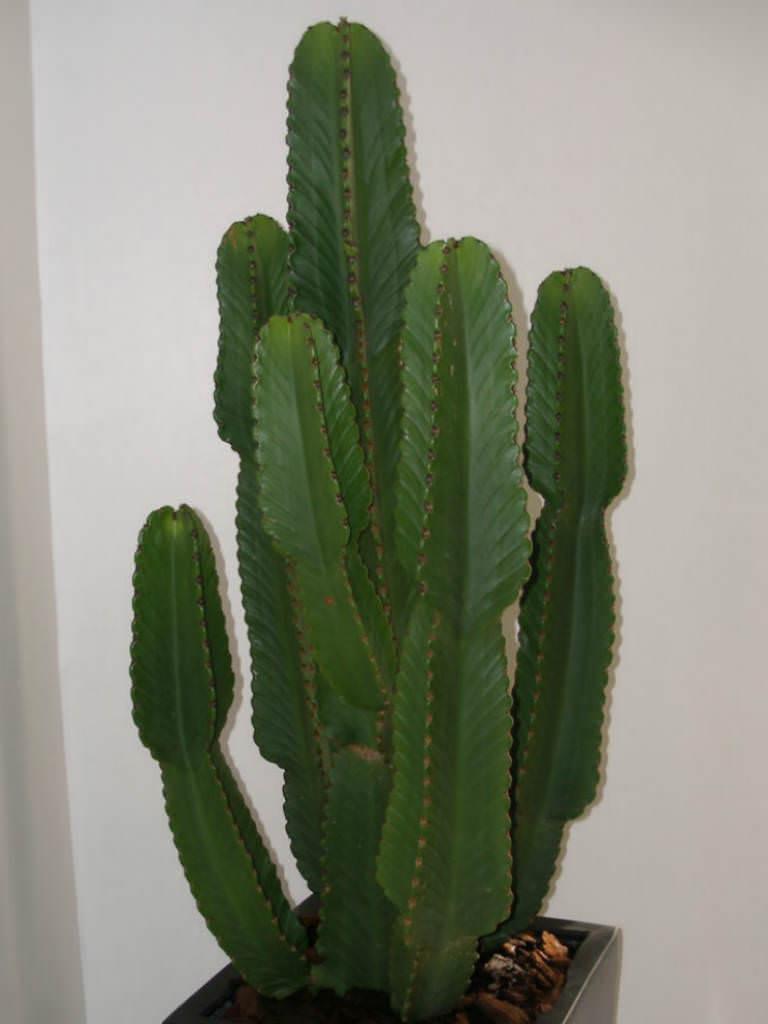
Synonyms
Euphorbia similis
Scientific Classification
Family: Euphorbiaceae
Subfamily: Euphorbioideae
Tribe: Euphorbieae
Subtribe: Euphorbiinae
Genus: Euphorbia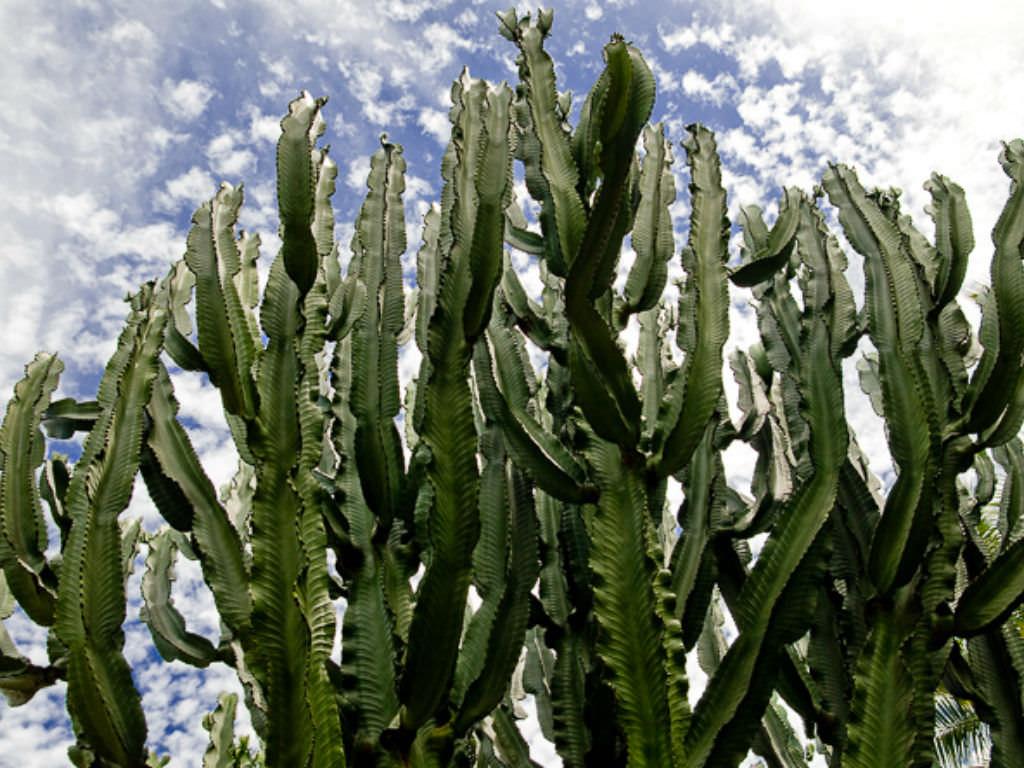
Description
Euphorbia ingens is an upright, succulent tree, up to 40 feet (12 m) tall, with a dark green crown which is well rounded and often shaped like a hot-air balloon. The branches are segmented with spines running along the ridges of the segments. It produces small, greenish yellow flowers on the ridges of the topmost segment of every branch from autumn to winter. The fruit is a round 3-lobed capsule, turns red to purple when ripening.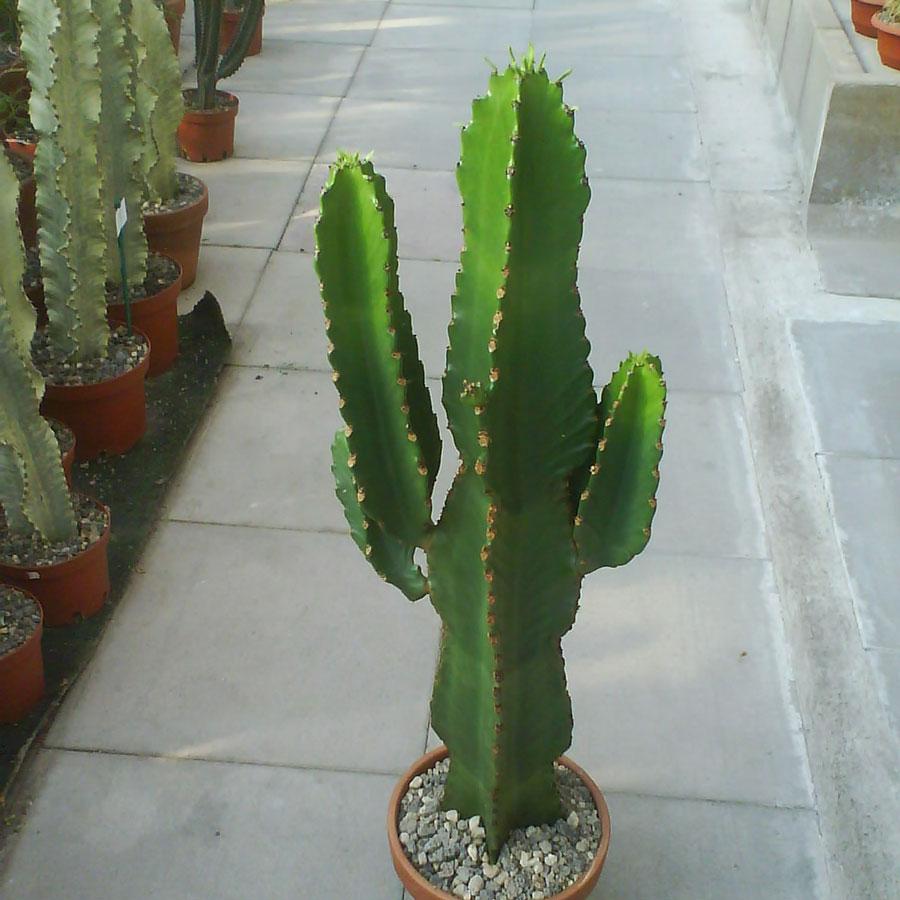
How to Grow and Care
Euphorbias are very easy to care for. They require a little pampering to become established, but once they are, they are self-sufficient. In fact, more die from too much care and watering than from neglect. Euphorbias need well-draining soil and lots of sunlight. They are not particular about soil pH, but they cannot tolerant wet soil. Unlike most succulents, Euphorbia does not handle long periods of drought well. It may need weekly watering during the summer.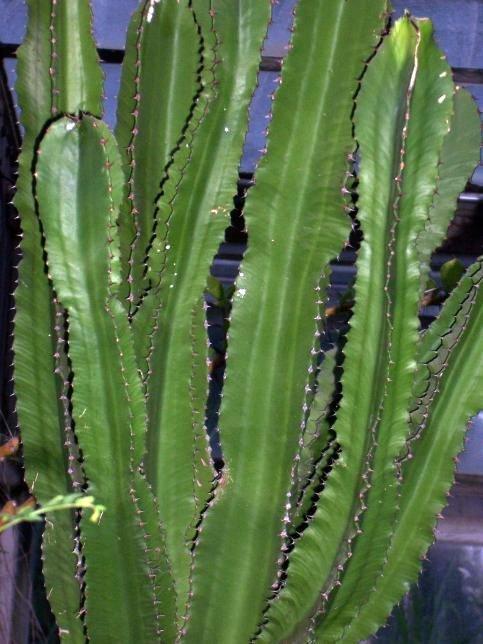
Euphorbia can be grown from seed, but they can be difficult to germinate (or even find). It is usually propagated by cuttings. This can be tricky, because of the exuding sap.
Euphorbia ingens E. Mey. ex Boiss.
Common Names
Candelabra Tree, Common Tree Euphorbia, Cactus Euphorbia, Cactus Spurge, Naboom (African), Kaktus-Wolfsmilch (German)

Synonyms
Euphorbia similis
Scientific Classification
Family: Euphorbiaceae
Subfamily: Euphorbioideae
Tribe: Euphorbieae
Subtribe: Euphorbiinae
Genus: Euphorbia

Description
Euphorbia ingens is an upright, succulent tree, up to 40 feet (12 m) tall, with a dark green crown which is well rounded and often shaped like a hot-air balloon. The branches are segmented with spines running along the ridges of the segments. It produces small, greenish yellow flowers on the ridges of the topmost segment of every branch from autumn to winter. The fruit is a round 3-lobed capsule, turns red to purple when ripening.

How to Grow and Care
Euphorbias are very easy to care for. They require a little pampering to become established, but once they are, they are self-sufficient. In fact, more die from too much care and watering than from neglect. Euphorbias need well-draining soil and lots of sunlight. They are not particular about soil pH, but they cannot tolerant wet soil. Unlike most succulents, Euphorbia does not handle long periods of drought well. It may need weekly watering during the summer.

Euphorbia can be grown from seed, but they can be difficult to germinate (or even find). It is usually propagated by cuttings. This can be tricky, because of the exuding sap.
1
1
文章
Dummer. ゛☀
2017年10月02日

Scientific Name
Hatiora salicornioides (Haw.) Britton & Rose
Common Names
Dancing Bones, Dancing Bones Cactus, Drunkard’s Dream, Spice Cactus, Bottle Cactus
Synonyms
Rhipsalis salicornioides (basionym)
Scientific Classification
Family: Cactaceae
Subfamily: Cactoideae
Tribe: Rhipsalideae
Genus: Hatiora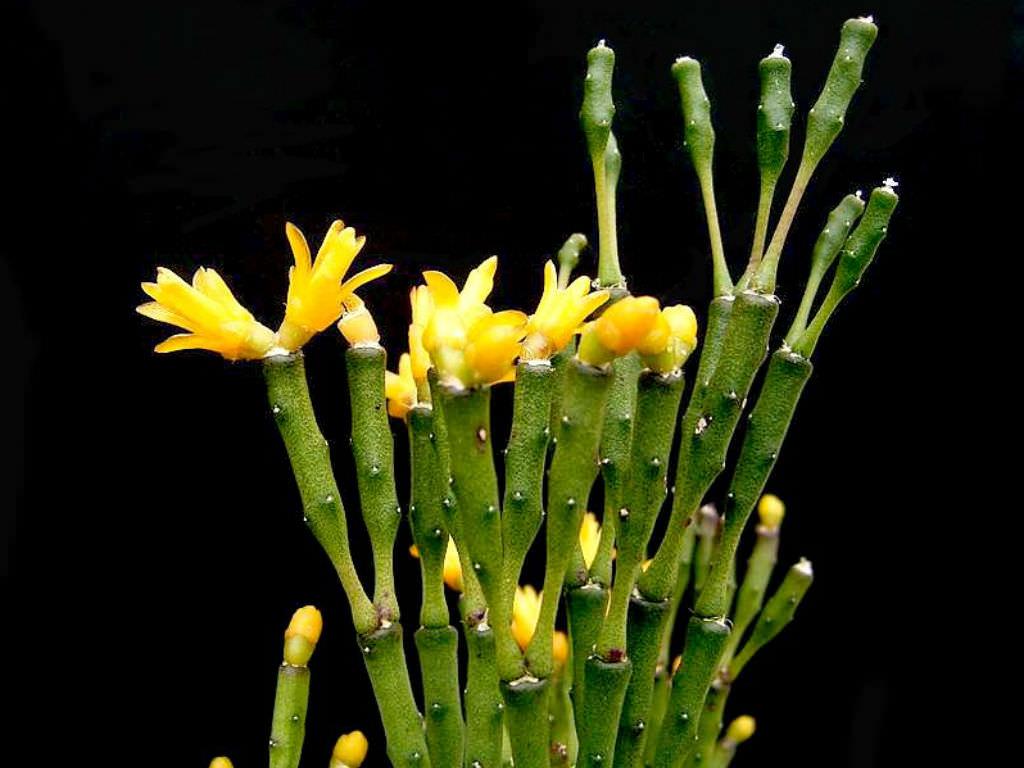
Description
Hatiora salicornioides is a slender, erect, arching or somewhat pendent, bushy, cactus, up to 2 feet (60 cm) tall. A stem consists of smaller segments, up to 1.2 inches (3 cm) long. The flowers are small, bell-shaped, orange yellow in color, up to 0.8 inch (2 cm) long and in diameter.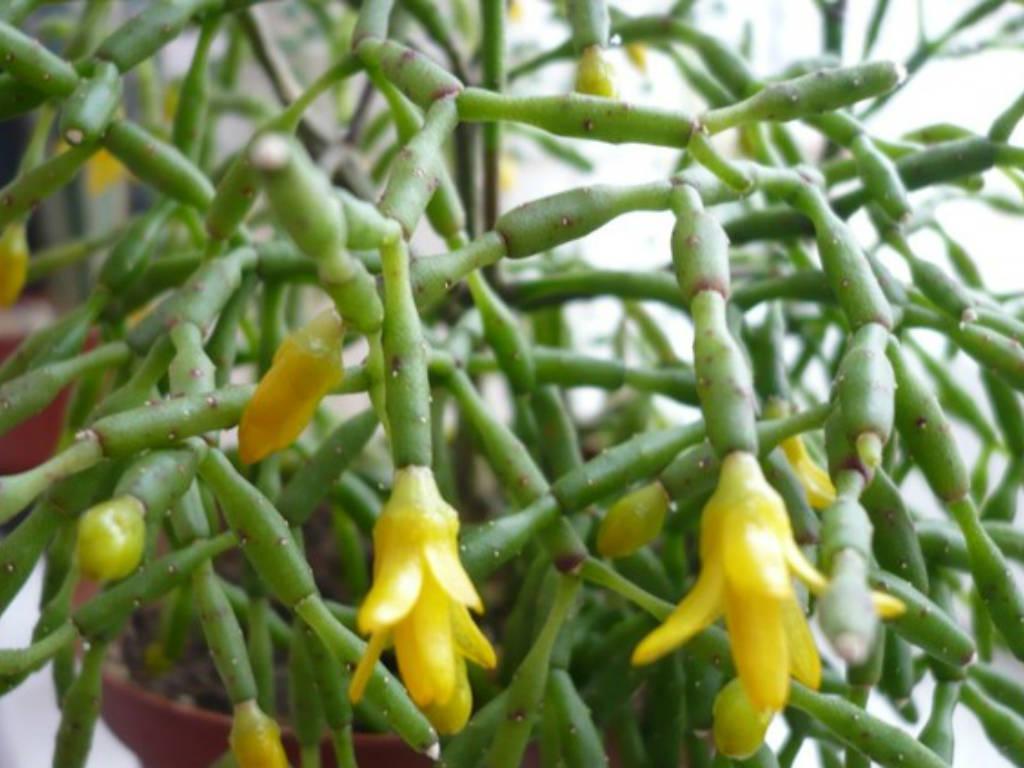
How to Grow and Care
Hatiora thrives best in indirect light with exposure to morning and evening sun. Hatioras prefers spring, summer, and fall temperatures around 75-80 °F (24-27 °C). Winter temperatures should be between 45-65 °F (7-18 °C) only. It prefers a well drained soil. Cactus or epiphytic compost works well. It can be propagated easily through cuttings that can root immediately in soil. Hatiora likes long nights of about 14 hours. Cover the plant with a paper bag to shut out sunlight. Try not to reposition the plant once flower buds appear, as these could fall off during any movement. It needs a month’s rest after flowering, so water sparingly during this period. Hatioras prefers fertilization every 14 days. Use a balanced 10-10-10 fertilizer, and dilute to half strength.
Hatiora salicornioides (Haw.) Britton & Rose
Common Names
Dancing Bones, Dancing Bones Cactus, Drunkard’s Dream, Spice Cactus, Bottle Cactus

Synonyms
Rhipsalis salicornioides (basionym)
Scientific Classification
Family: Cactaceae
Subfamily: Cactoideae
Tribe: Rhipsalideae
Genus: Hatiora

Description
Hatiora salicornioides is a slender, erect, arching or somewhat pendent, bushy, cactus, up to 2 feet (60 cm) tall. A stem consists of smaller segments, up to 1.2 inches (3 cm) long. The flowers are small, bell-shaped, orange yellow in color, up to 0.8 inch (2 cm) long and in diameter.

How to Grow and Care
Hatiora thrives best in indirect light with exposure to morning and evening sun. Hatioras prefers spring, summer, and fall temperatures around 75-80 °F (24-27 °C). Winter temperatures should be between 45-65 °F (7-18 °C) only. It prefers a well drained soil. Cactus or epiphytic compost works well. It can be propagated easily through cuttings that can root immediately in soil. Hatiora likes long nights of about 14 hours. Cover the plant with a paper bag to shut out sunlight. Try not to reposition the plant once flower buds appear, as these could fall off during any movement. It needs a month’s rest after flowering, so water sparingly during this period. Hatioras prefers fertilization every 14 days. Use a balanced 10-10-10 fertilizer, and dilute to half strength.
1
1
文章
Dummer. ゛☀
2017年10月02日

Scientific Name
Epithelantha bokei L.D. Benson
Common Names
Pingpong Ball Cactus, Button Cactus, Boke’s Button Cactus
Synonyms
Epithelantha micromeris subsp. bokei
Scientific Classification
Family: Cactaceae
Subfamily: Cactoideae
Tribe: Cacteae
Subtribe: Cactinae
Genus: Epithelantha
Description
Epithelantha bokei is a disc-shaped or cylindrical cactus, up to 2 inches (5 cm) tall and usually unbranched. It is so thickly covered in pale-colored spines that it is white or yellowish in color. There are up to 90 on each areole. The delicate pale pink flowers are up to 0.7 inch (1.7 cm) long and wide. The red fruit is 0.4 inch (1 cm) long. Much of the plant is located below ground, with a few centimeters above. It contracts into the ground during dry periods.
How to Grow and Care
To encourage better flowering, allow the plants to enjoy a cooling period in the winter and suspend watering. Unlike many other cacti, which use their ribs as storage devices, the Mammillaria feature raised tubercles, from which spines emerge. When you water, the tubercles will expand to allow for increased water storage. The flowers emerge from the axils of these tubercles on the previous year’s growth, which accounts for their interesting halo effect. It’s imperative that the cactus is not exposed to prolonged dampness and sitting water. Never let your cactus sit in a dish of water. Lastly, make sure to fertilizer during the growing season for the best results.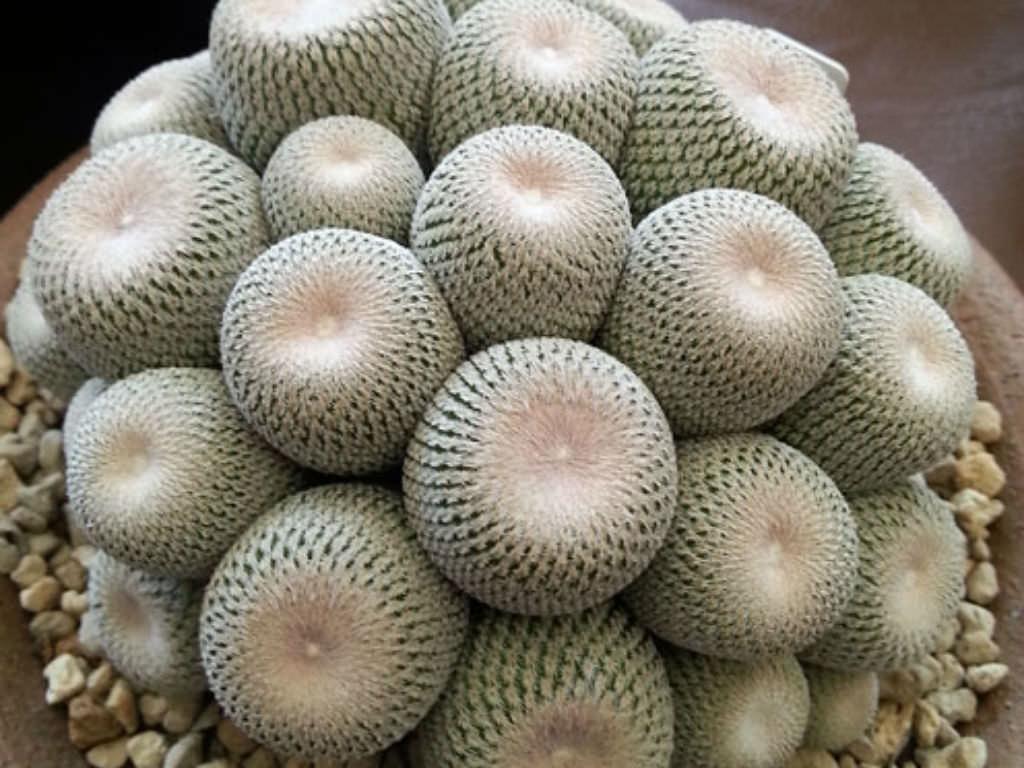
Repot as needed, preferably during the warm season. To repot a cacti, make sure the soil is dry before repotting, then gently remove the pot.
Epithelantha bokei L.D. Benson
Common Names
Pingpong Ball Cactus, Button Cactus, Boke’s Button Cactus

Synonyms
Epithelantha micromeris subsp. bokei
Scientific Classification
Family: Cactaceae
Subfamily: Cactoideae
Tribe: Cacteae
Subtribe: Cactinae
Genus: Epithelantha

Description
Epithelantha bokei is a disc-shaped or cylindrical cactus, up to 2 inches (5 cm) tall and usually unbranched. It is so thickly covered in pale-colored spines that it is white or yellowish in color. There are up to 90 on each areole. The delicate pale pink flowers are up to 0.7 inch (1.7 cm) long and wide. The red fruit is 0.4 inch (1 cm) long. Much of the plant is located below ground, with a few centimeters above. It contracts into the ground during dry periods.

How to Grow and Care
To encourage better flowering, allow the plants to enjoy a cooling period in the winter and suspend watering. Unlike many other cacti, which use their ribs as storage devices, the Mammillaria feature raised tubercles, from which spines emerge. When you water, the tubercles will expand to allow for increased water storage. The flowers emerge from the axils of these tubercles on the previous year’s growth, which accounts for their interesting halo effect. It’s imperative that the cactus is not exposed to prolonged dampness and sitting water. Never let your cactus sit in a dish of water. Lastly, make sure to fertilizer during the growing season for the best results.

Repot as needed, preferably during the warm season. To repot a cacti, make sure the soil is dry before repotting, then gently remove the pot.
0
0
文章
Dummer. ゛☀
2017年10月02日

Scientific Name
Opuntia microdasys subsp. rufida (Engelm.) U. Guzmán & Mandujano.
Common Names
Blind Prickly Pear, Blind Pear, Cow Blinder, Cinnamon Cactus, Clock Face Cactus, Cactus Red Bunny Ears, Cinnamon Pear, Cinnamon Bunny Ears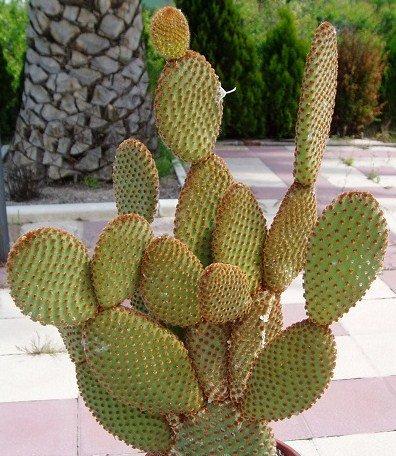
Synonyms
Opuntia rufida (Basionym), Opuntia herrfeldtii, Opuntia lubrica, Opuntia microdasys var. rufida, Ountia rufida var. tortiflora
Scientific Classification
Family: Cactaceae
Subfamily: Opuntioideae
Tribe: Opuntieae
Genus: Opuntia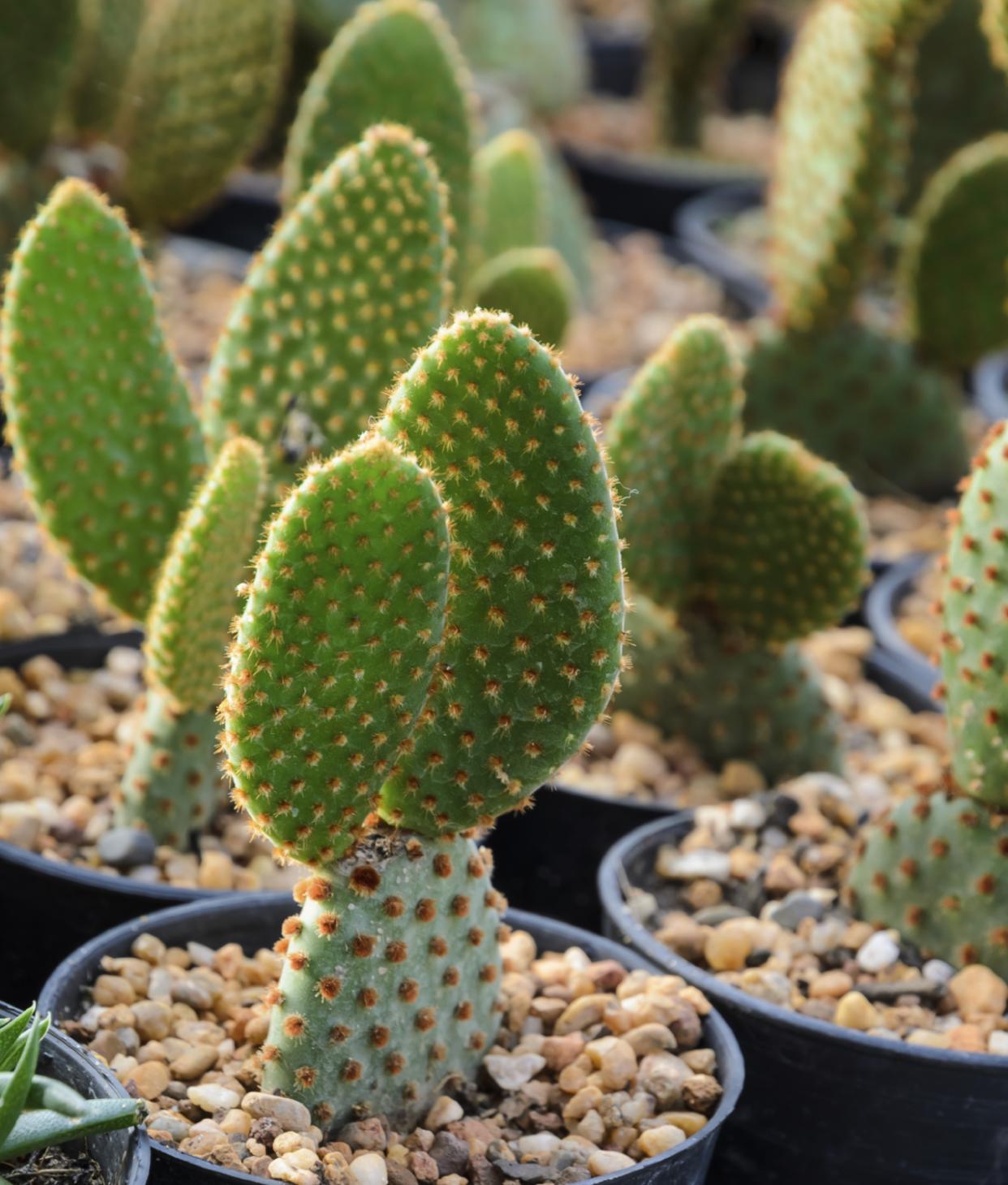
Description
Opuntia microdasys subsp. rufida is an upright and spreading, much branched cactus, up to 5 feet (1.5 m) tall. Stems are jointed into fleshy, rounded pads that are various in color, from lucid purple when young to glacous blue with age. Glochids densely arrayed, greyish to reddish brown, rarely with spines. The flowers are yellow to bright orange-red and about 3 inches (7.5 cm) across. The fruit is rounded, fleshy, with very short spines, yellow-green ripening to red and 1 inch (2.5 cm) long.
Hardiness
USDA hardiness zone 9a to 10b: from 20 °F (−6.7 °C) to 40 °F (+4.4 °C).
How to Grow and Care
Though the large variety of species within the Opuntia genus means different types of prickly pears may need slightly different care, all are desert cacti that need lots of sun, lots of light, and very little water. If you live in a hot, arid area – particularly the American Southwest – these plants can generally be planted outside, left alone, and enjoyed.
Prickly pears can propagate either by cuttings or by seed. To propagate by cuttings, sever pads from a plant and let them dry so that the wounds heal. Then place the plants in a dry soil and refrain from watering them until they begin to grow to avoid rotting them.
Opuntia microdasys subsp. rufida (Engelm.) U. Guzmán & Mandujano.
Common Names
Blind Prickly Pear, Blind Pear, Cow Blinder, Cinnamon Cactus, Clock Face Cactus, Cactus Red Bunny Ears, Cinnamon Pear, Cinnamon Bunny Ears

Synonyms
Opuntia rufida (Basionym), Opuntia herrfeldtii, Opuntia lubrica, Opuntia microdasys var. rufida, Ountia rufida var. tortiflora
Scientific Classification
Family: Cactaceae
Subfamily: Opuntioideae
Tribe: Opuntieae
Genus: Opuntia

Description
Opuntia microdasys subsp. rufida is an upright and spreading, much branched cactus, up to 5 feet (1.5 m) tall. Stems are jointed into fleshy, rounded pads that are various in color, from lucid purple when young to glacous blue with age. Glochids densely arrayed, greyish to reddish brown, rarely with spines. The flowers are yellow to bright orange-red and about 3 inches (7.5 cm) across. The fruit is rounded, fleshy, with very short spines, yellow-green ripening to red and 1 inch (2.5 cm) long.

Hardiness
USDA hardiness zone 9a to 10b: from 20 °F (−6.7 °C) to 40 °F (+4.4 °C).
How to Grow and Care
Though the large variety of species within the Opuntia genus means different types of prickly pears may need slightly different care, all are desert cacti that need lots of sun, lots of light, and very little water. If you live in a hot, arid area – particularly the American Southwest – these plants can generally be planted outside, left alone, and enjoyed.

Prickly pears can propagate either by cuttings or by seed. To propagate by cuttings, sever pads from a plant and let them dry so that the wounds heal. Then place the plants in a dry soil and refrain from watering them until they begin to grow to avoid rotting them.
3
1
文章
Dummer. ゛☀
2017年10月01日

Scientific Name
Astrophytum myriostigma var. nudum (Rud.Mey.) Frič
Common Names
Bishop’s Cap Cactus, Bishop’s Cap, Bishop’s Hat, Bishop’s Miter Cactus, Bishop’s Hood
Synonyms
Astrophytum myriostigma subsp. nudum, Echinocactus myriostigma var. nudus
Scientific Classification
Family: Cactaceae
Subfamily: Cactoideae
Tribe: Cacteae
Genus: Astrophytum
Description
Astrophytum myriostigma var. nudum is very similar to Astrophytum myriostigma, it only deviate from the well-known typical form for lacking or mostly lacking white flecks. The stem is spherical to shortly columnar with age, up to 3.3 feet (1 m) tall and up to 4 inches (10 cm) in diameter. The number of ribs vary from 3 to 8 (usually 5). Flowers are up to 2 inches (5 cm) long, pale-yellow and bloom in spring or early summer. It take up to 6 years to bloom.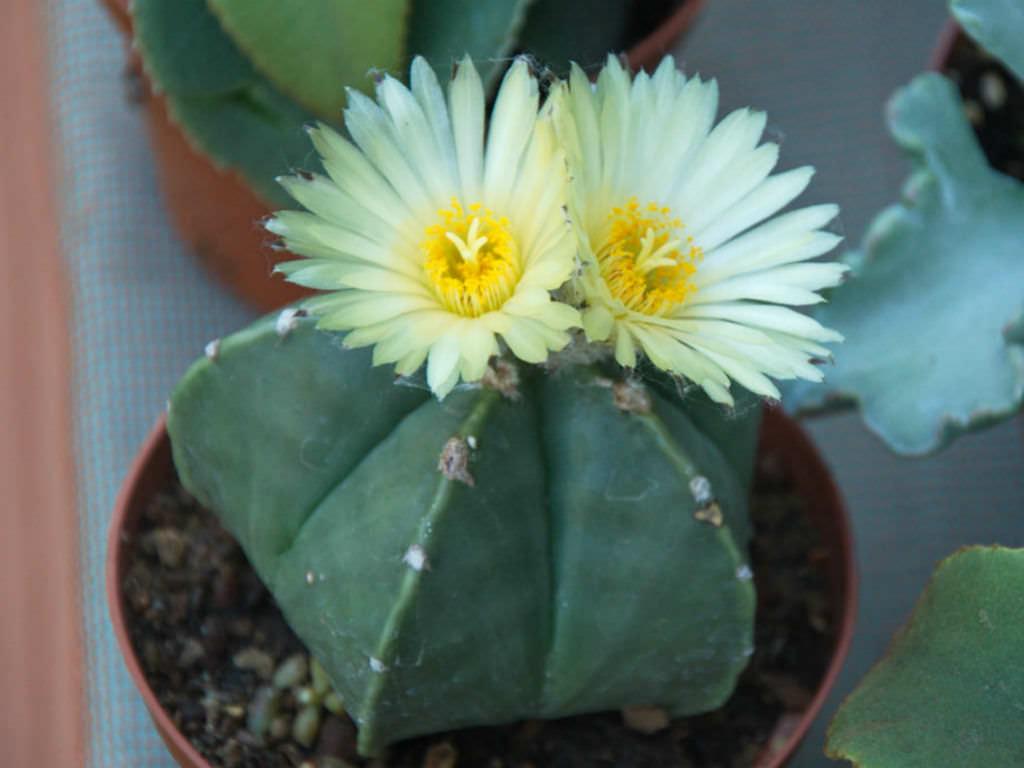
How to Grow and Care
Astrophytums are not vigorous plants and they require a lot of patience to reach their full potential. Keep regularly watering and feeding them during the growing season and repot annually to give them space to develop. They need a temperate, dry winter as well, and make sure not to overwater them to avoid rotting their roots. If given sufficient care, they will develop marvelous flowers once they reach maturity.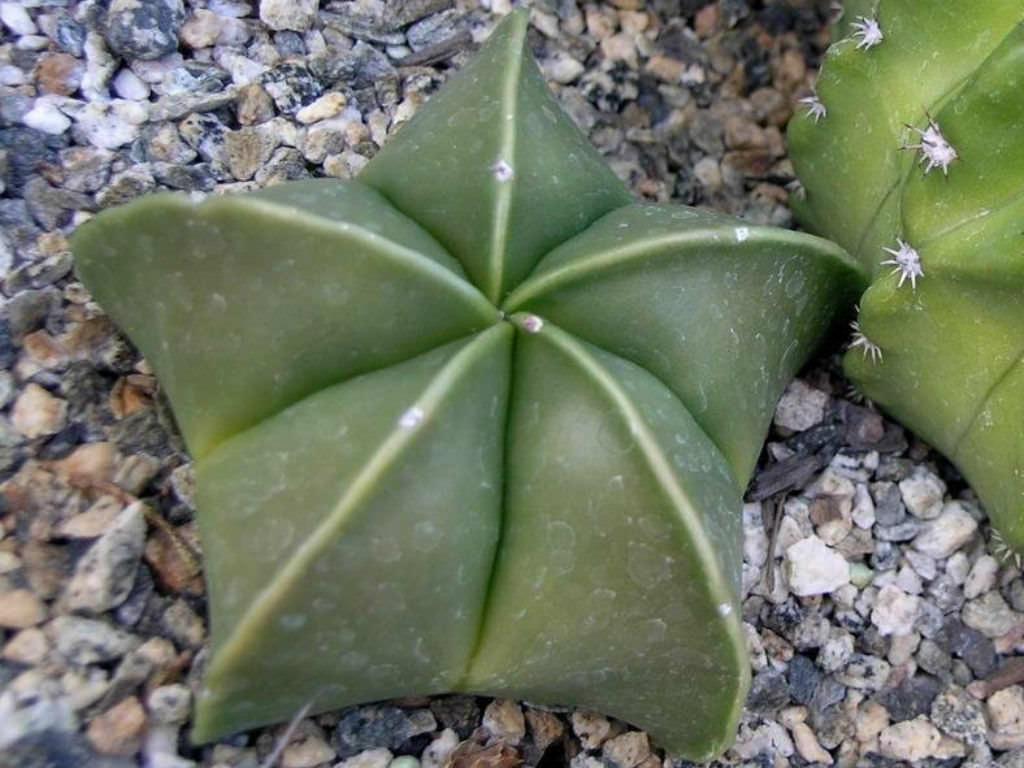
Repot regularly to help them develop. Astrophytums should be repotted at the beginning of the growing season for best results, allowing them to grow into the impressive specimens for which the genus is known. Protect your hands before repotting due to their stiff spikes and lift the plant out all at once, then replace in a larger pot and backfill with soil.
Astrophytum myriostigma var. nudum (Rud.Mey.) Frič
Common Names
Bishop’s Cap Cactus, Bishop’s Cap, Bishop’s Hat, Bishop’s Miter Cactus, Bishop’s Hood
Synonyms
Astrophytum myriostigma subsp. nudum, Echinocactus myriostigma var. nudus
Scientific Classification
Family: Cactaceae
Subfamily: Cactoideae
Tribe: Cacteae
Genus: Astrophytum

Description
Astrophytum myriostigma var. nudum is very similar to Astrophytum myriostigma, it only deviate from the well-known typical form for lacking or mostly lacking white flecks. The stem is spherical to shortly columnar with age, up to 3.3 feet (1 m) tall and up to 4 inches (10 cm) in diameter. The number of ribs vary from 3 to 8 (usually 5). Flowers are up to 2 inches (5 cm) long, pale-yellow and bloom in spring or early summer. It take up to 6 years to bloom.

How to Grow and Care
Astrophytums are not vigorous plants and they require a lot of patience to reach their full potential. Keep regularly watering and feeding them during the growing season and repot annually to give them space to develop. They need a temperate, dry winter as well, and make sure not to overwater them to avoid rotting their roots. If given sufficient care, they will develop marvelous flowers once they reach maturity.

Repot regularly to help them develop. Astrophytums should be repotted at the beginning of the growing season for best results, allowing them to grow into the impressive specimens for which the genus is known. Protect your hands before repotting due to their stiff spikes and lift the plant out all at once, then replace in a larger pot and backfill with soil.
0
0
文章
Dummer. ゛☀
2017年10月01日

Scientific Name
Escobaria minima (Baird) D. R. Hunt
Common Names
Nellie Cory Cactus, Nellie’s Pincushion Cactus, Birdfoot Cactus, Dwarf Cory Cactus, Least Cory Cactus
Synonyms
Coryphantha minima (basionym), Coryphantha nellieae, Escobaria nellieae, Mammillaria nellieae
Scientific Classification
Family: Cactaceae
Subfamily: Cactoideae
Tribe: Cacteae
Genus: Escobaria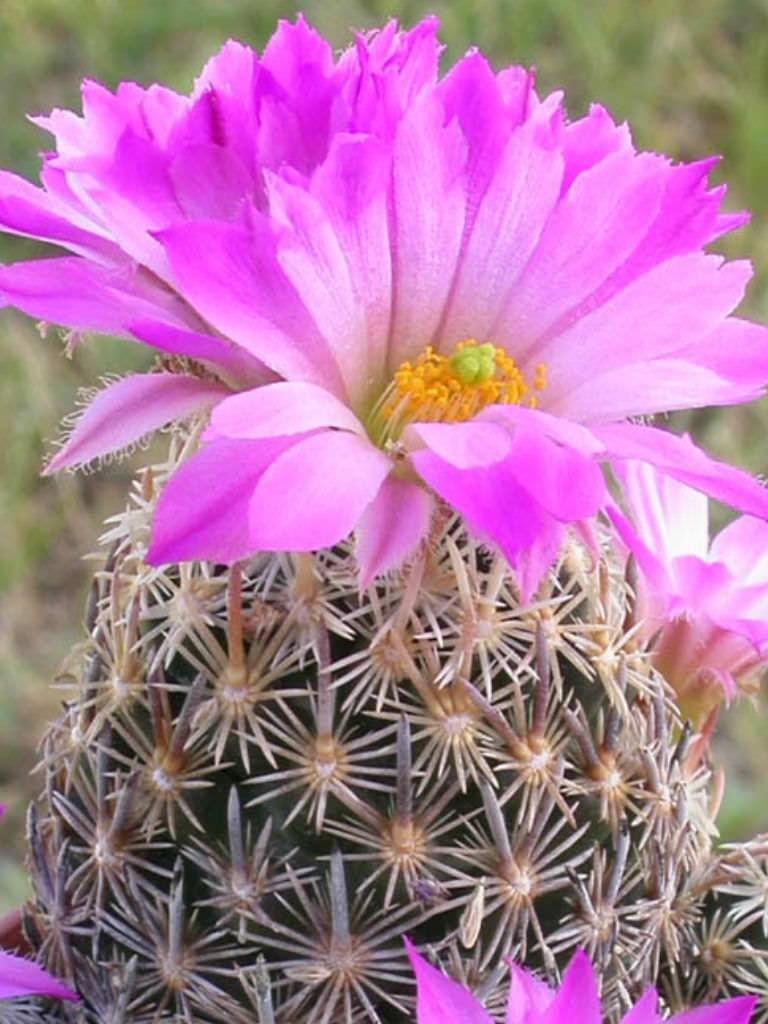
Description
Escobaria minima is a tiny cactus with rounded, single stems up to i inch (2,5 cm) tall and up to 0.7 inch (1.8 cm) wide. The plant is crowded with thick, corky, white spines. Flowers are pink, up to 1 inch (2.5 cm) in diameter and 0.6 inch (1.6 cm) long. It blooms in several flushes, primarily in May, but the blooming period lasts from March until June. The fruita are ovoid, green, up to 2 inches (5 cm) long.
How to Grow and Care
The Escobaria are very susceptible to rot and therefore require a well-drained soil, without any water excess or stagnation; it has been observed that the plants also suffer the environmental humidity, which should preferably remain very low (30-50%). Avoid watering during the winter, when the plant is dormant: watering Escobaria in cold environmental conditions will almost certainly lead to death of the plant. In the growing season the plants, whose growth is typically quite slow, like to perceive a significant temperature difference between night and day. The experienced grower knows well the difficulties of survival of this genus, certainly not one of the easiest to grow.
Escobaria minima (Baird) D. R. Hunt
Common Names
Nellie Cory Cactus, Nellie’s Pincushion Cactus, Birdfoot Cactus, Dwarf Cory Cactus, Least Cory Cactus
Synonyms
Coryphantha minima (basionym), Coryphantha nellieae, Escobaria nellieae, Mammillaria nellieae
Scientific Classification
Family: Cactaceae
Subfamily: Cactoideae
Tribe: Cacteae
Genus: Escobaria

Description
Escobaria minima is a tiny cactus with rounded, single stems up to i inch (2,5 cm) tall and up to 0.7 inch (1.8 cm) wide. The plant is crowded with thick, corky, white spines. Flowers are pink, up to 1 inch (2.5 cm) in diameter and 0.6 inch (1.6 cm) long. It blooms in several flushes, primarily in May, but the blooming period lasts from March until June. The fruita are ovoid, green, up to 2 inches (5 cm) long.

How to Grow and Care
The Escobaria are very susceptible to rot and therefore require a well-drained soil, without any water excess or stagnation; it has been observed that the plants also suffer the environmental humidity, which should preferably remain very low (30-50%). Avoid watering during the winter, when the plant is dormant: watering Escobaria in cold environmental conditions will almost certainly lead to death of the plant. In the growing season the plants, whose growth is typically quite slow, like to perceive a significant temperature difference between night and day. The experienced grower knows well the difficulties of survival of this genus, certainly not one of the easiest to grow.
0
0
文章
Dummer. ゛☀
2017年10月01日

Scientific Name
Myrtillocactus geometrizans (Mart. ex Pfeiff.) Console
Common Names
Bilberry Cactus, Whortleberry Cactus, Blue Candle
Synonyms
Cereus geometrizans, Myrtillocactus grandiareolatus
Scientific Classification
Family: Cactaceae
Subfamily: Cactoideae
Tribe: Echinocereeae
Genus: Myrtillocactus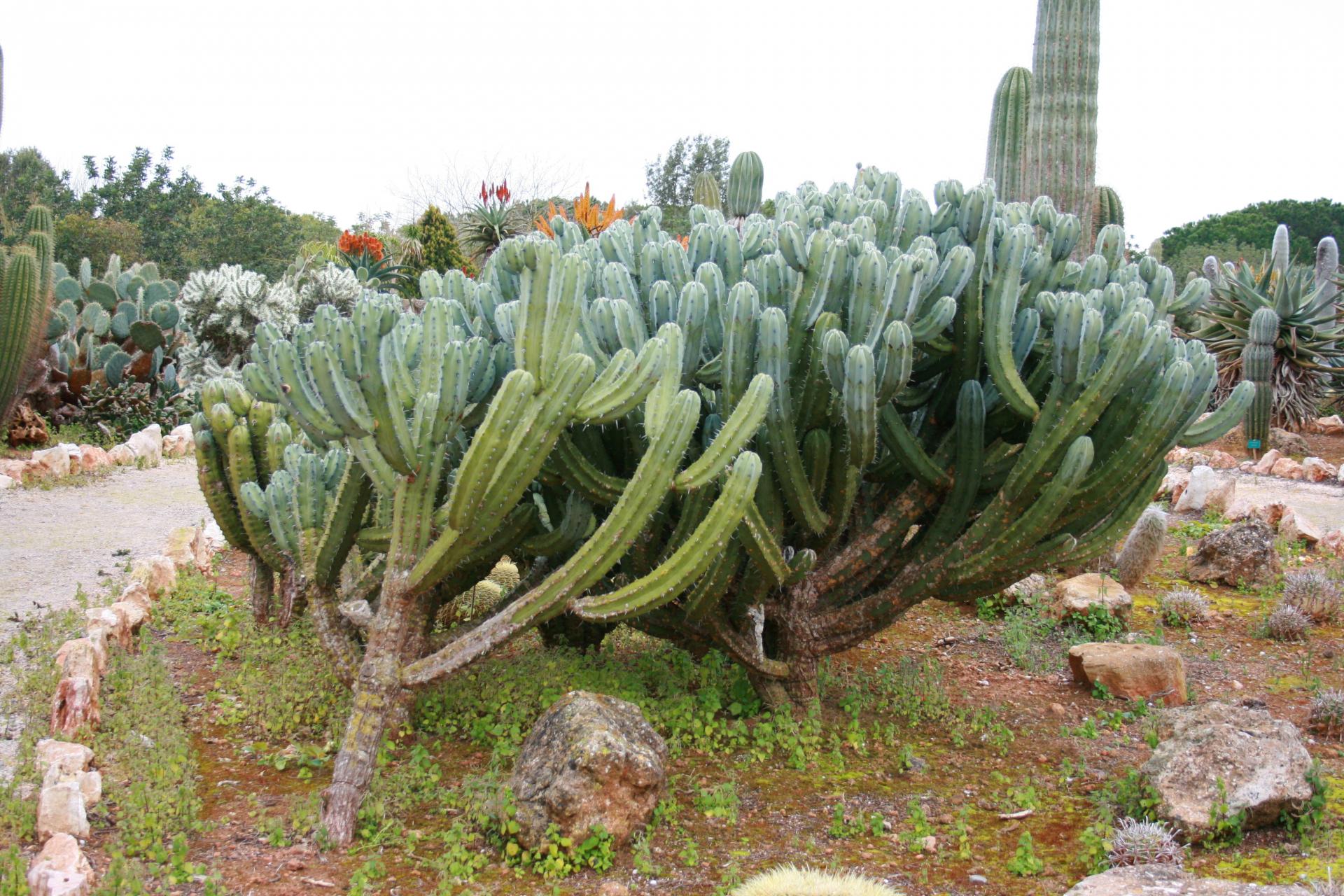
Description
Myrtillocactus geometrizans is a large shrubby cactus growing up to 16.5 feet (5 m) tall, with candelabra-like branching on mature plants. It is fast growing, and is often used as grafting stock because of this. The individual stems are up to 4 inches (10 cm) diameter, with five (occasionally six) ribs, with areoles spaced up to 1.2 inches (3 cm) apart. The flowers are creamy white, up to 1 inch (2.5 cm) in diameter. The fruit is an edible dark purple berry up to 1 inch (2.5 cm) in diameter.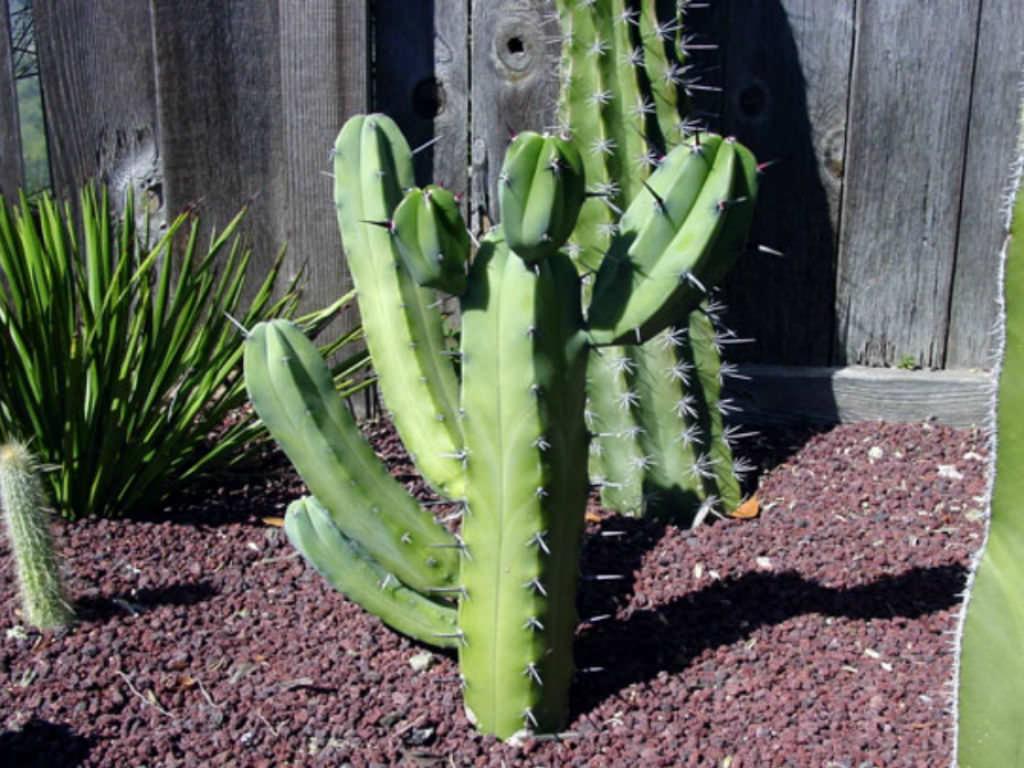
How to Grow and Care
They are semi hardy, make sure that your Myrtillocactus are not exposed to temperatures below 25°F (-4°C) or they may die, nevertheless it is a good advice never let the nighttime’s temperatures fall below 50°F (10°C). In the summer place Myrtillocactus in the sunshine (indoors or outdoors). In the winter find a cooler, light spot. That will allow it to go into next spring well-rested, which will make it more likely to flower. This easy-care plant doesn’t want a lot of water. Allow the soil to dry out before you give it another drink. Keep the soil completely dry in winter. Treat it to special cactus food once a month in the spring and summer.
Myrtillocactus geometrizans (Mart. ex Pfeiff.) Console
Common Names
Bilberry Cactus, Whortleberry Cactus, Blue Candle
Synonyms
Cereus geometrizans, Myrtillocactus grandiareolatus
Scientific Classification
Family: Cactaceae
Subfamily: Cactoideae
Tribe: Echinocereeae
Genus: Myrtillocactus

Description
Myrtillocactus geometrizans is a large shrubby cactus growing up to 16.5 feet (5 m) tall, with candelabra-like branching on mature plants. It is fast growing, and is often used as grafting stock because of this. The individual stems are up to 4 inches (10 cm) diameter, with five (occasionally six) ribs, with areoles spaced up to 1.2 inches (3 cm) apart. The flowers are creamy white, up to 1 inch (2.5 cm) in diameter. The fruit is an edible dark purple berry up to 1 inch (2.5 cm) in diameter.

How to Grow and Care
They are semi hardy, make sure that your Myrtillocactus are not exposed to temperatures below 25°F (-4°C) or they may die, nevertheless it is a good advice never let the nighttime’s temperatures fall below 50°F (10°C). In the summer place Myrtillocactus in the sunshine (indoors or outdoors). In the winter find a cooler, light spot. That will allow it to go into next spring well-rested, which will make it more likely to flower. This easy-care plant doesn’t want a lot of water. Allow the soil to dry out before you give it another drink. Keep the soil completely dry in winter. Treat it to special cactus food once a month in the spring and summer.
1
1
文章
Dummer. ゛☀
2017年10月01日

Scientific Name
Pachycereus schottii ‘Big Penis Cactus’
Common Names
Big Penis Cactus
Synonyms
Lophocereus schottii ‘Big Penis Cactus’
Scientific Classification
Family: Cactaceae
Subfamily: Cactoideae
Tribe: Pachycereeae
Genus: Pachycereus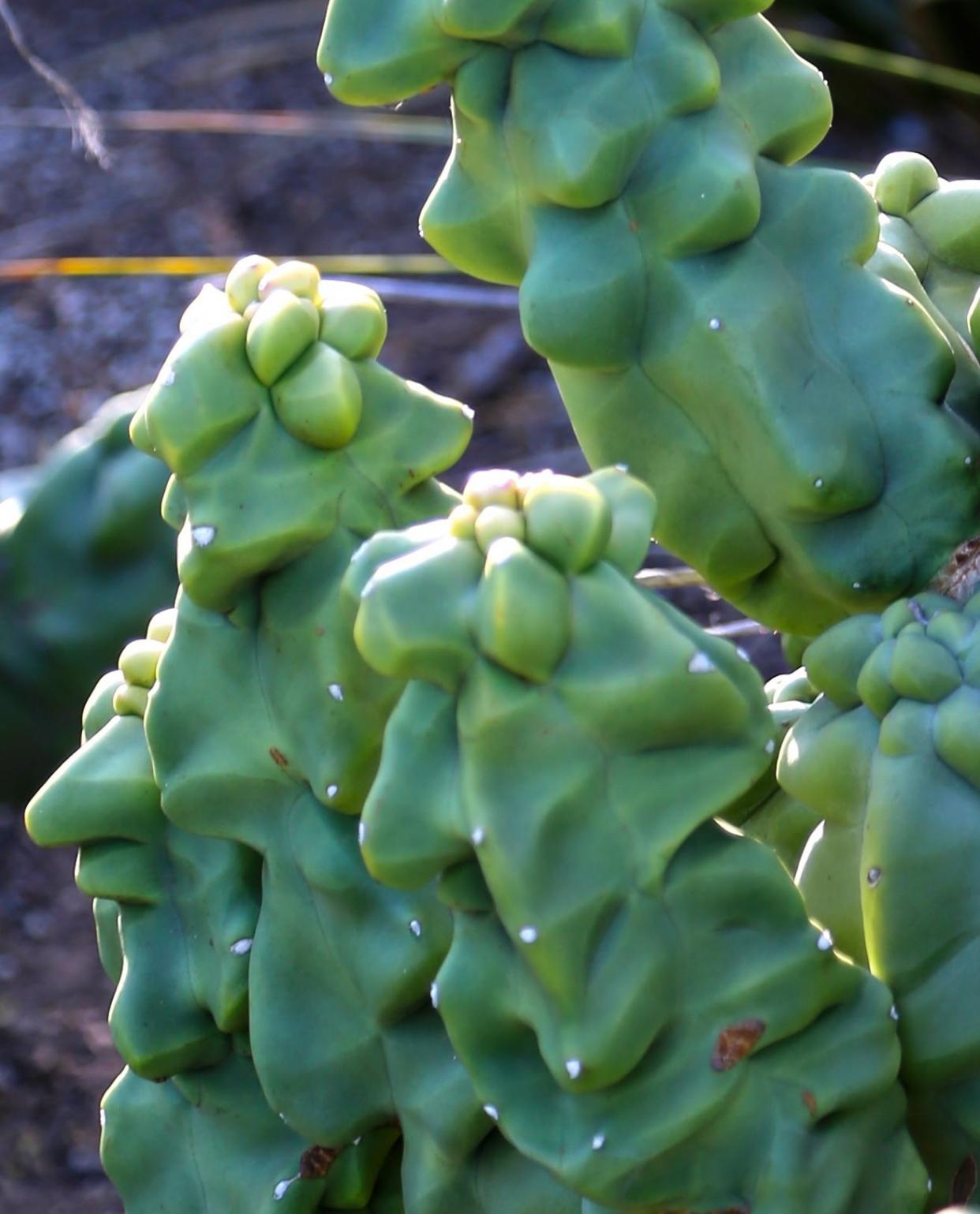
Description
Pachycereus schottii ‘Big Penis Cactus’ is a controversial, monstrous cactus cultivar with variable, irregularly shaped rib-less stems. Stems are ascending, lightly pruinose, and also branch just from the base. Stems usually remain small less than 3.3 feet (1 m) tall. The stems mark quite badly with age, due to weathering and old age.
How to Grow and Care
These extraordinarily low-maintenance plants can basically grow untouched for decades, so there’s really not a lot you need to worry about. Obviously it’s very important that they receive adequate sun and heat, and be careful around their spines. If grown in containers, make sure that they’re being repotted and that their soil isn’t too moist. Other than that, these plants are about as simple and hands-off as it gets.
Like most cacti and succulents, these plants propagate by cuttings. Sever a branch and replant in well-drained soil. Make sure as well to stand the cactus up in an empty container to let its ends heal off before you replant it; this will keep its stems shaped right, and cacti with dried ends form roots more easily after planting.
Pachycereus schottii ‘Big Penis Cactus’
Common Names
Big Penis Cactus
Synonyms
Lophocereus schottii ‘Big Penis Cactus’
Scientific Classification
Family: Cactaceae
Subfamily: Cactoideae
Tribe: Pachycereeae
Genus: Pachycereus

Description
Pachycereus schottii ‘Big Penis Cactus’ is a controversial, monstrous cactus cultivar with variable, irregularly shaped rib-less stems. Stems are ascending, lightly pruinose, and also branch just from the base. Stems usually remain small less than 3.3 feet (1 m) tall. The stems mark quite badly with age, due to weathering and old age.

How to Grow and Care
These extraordinarily low-maintenance plants can basically grow untouched for decades, so there’s really not a lot you need to worry about. Obviously it’s very important that they receive adequate sun and heat, and be careful around their spines. If grown in containers, make sure that they’re being repotted and that their soil isn’t too moist. Other than that, these plants are about as simple and hands-off as it gets.

Like most cacti and succulents, these plants propagate by cuttings. Sever a branch and replant in well-drained soil. Make sure as well to stand the cactus up in an empty container to let its ends heal off before you replant it; this will keep its stems shaped right, and cacti with dried ends form roots more easily after planting.
1
0
文章
Dummer. ゛☀
2017年10月01日

Scientific Name
Hylocereus undatus (Haw.) Britton & Rose
Common Names
Night Blooming Cereus, Pitaya, Dragon Fruit, Strawberry Pear, White-Fleshed Pitahaya, Belle of the Night, Moonlight Cactus, Queen of the Night, Red Pitaya, Honolulu Queen, Conderella Plant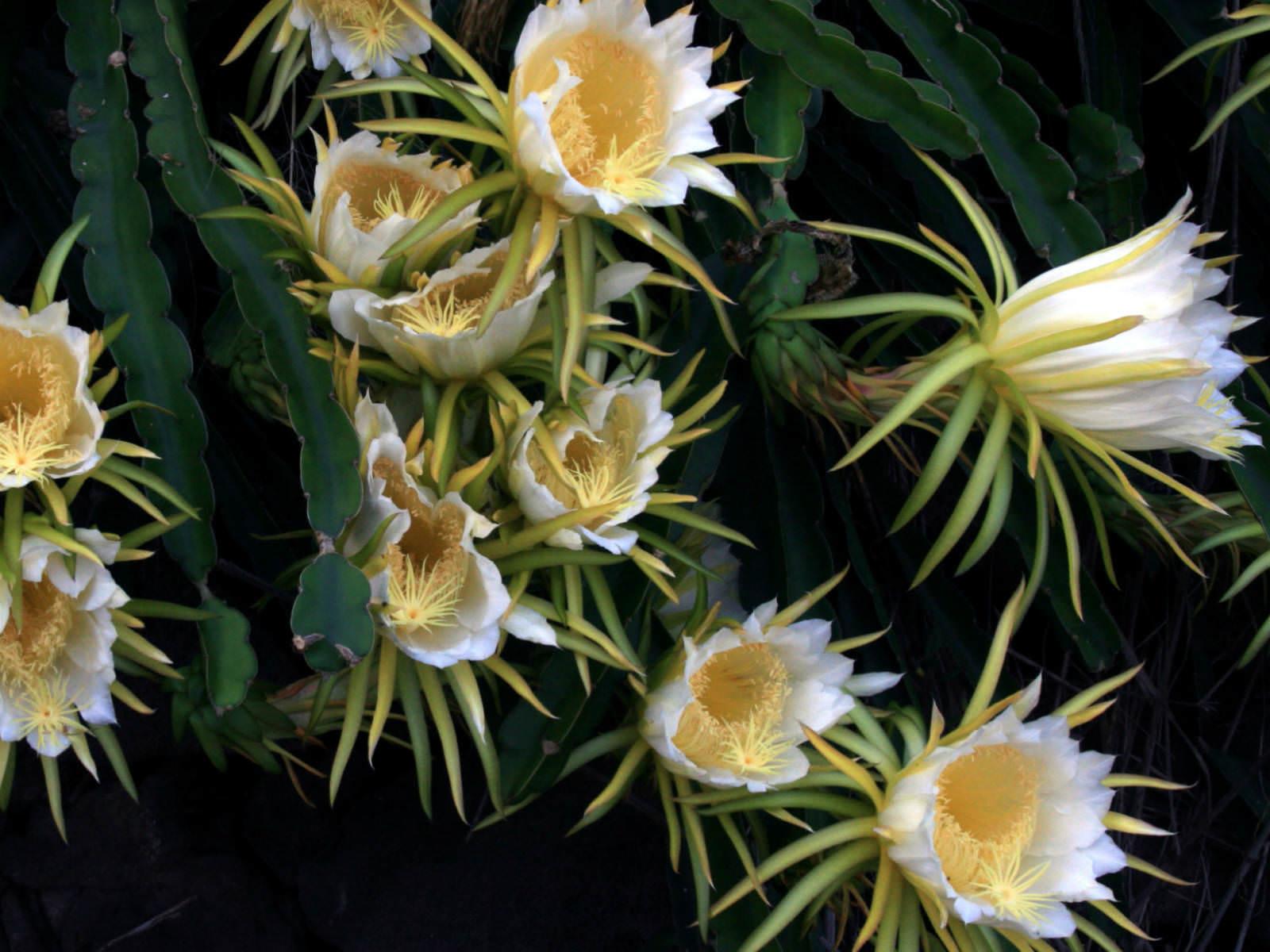
Synonyms
Cereus undatus (basionym), Cereus tricostatus, Cereus trigonus var. guatemalensis, Hylocereus tricostatus, Hylocereus guatemalensis
Scientific Classification
Family: Cactaceae
Subfamily: Cactoideae
Tribe: Hylocereeae
Genus: Hylocereus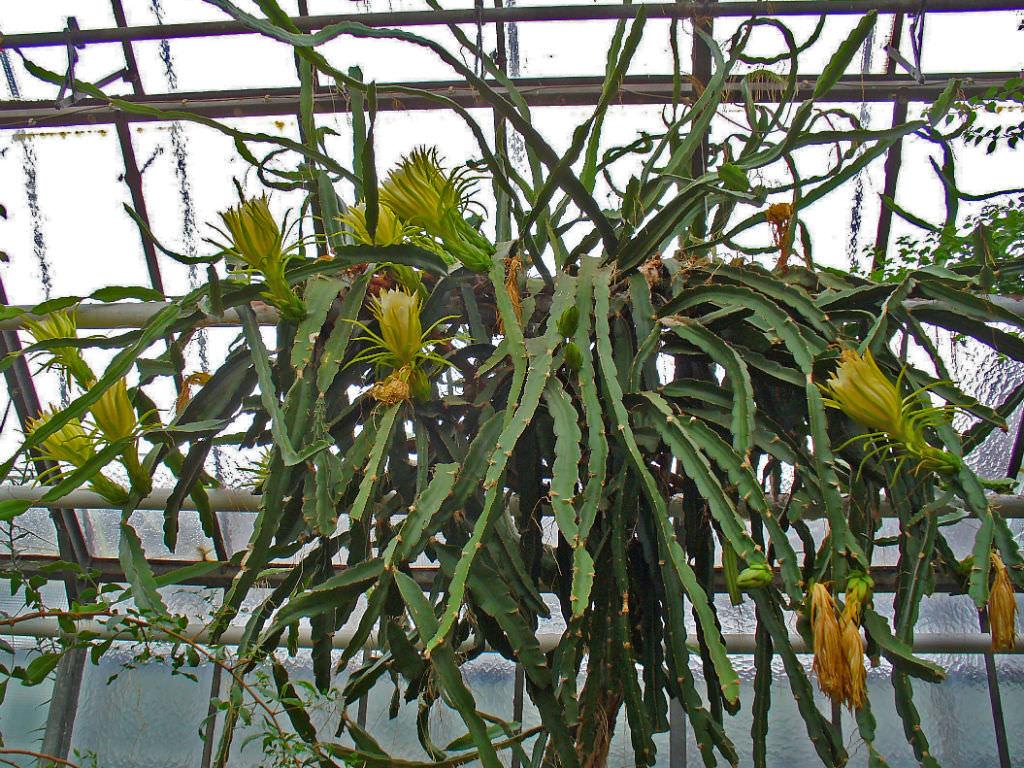
Description
Hylocereus undatus is a sprawling or vining, terrestrial or epiphytic cactus. The stems are green, 3-winged, up to 16.5 feet (5 m) long and up to 3 inches (7.5 cm) wide. They climb by use of aerial roots and can reach up to 33 feet (10 m) or longer, growing on rocks and trees. Margins are horny and undulate with wings that are up to 2 inches (5 cm) wide. Spines on adult branches are 1 – 3, grayish-brown to black in color and up to 1.2 inches (3 cm) long. The scented, nocturnal flowers are greenish-yellow or whitish, rarely rose-tinged with green outer tepals and bracts, up to 14 inches (35 cm) long and up to 12 inches (30 cm) in diameter. The fruit is oblong to oval, up to 4.7 inches (12 cm) long and up to 3.5 inches (9 cm) thick.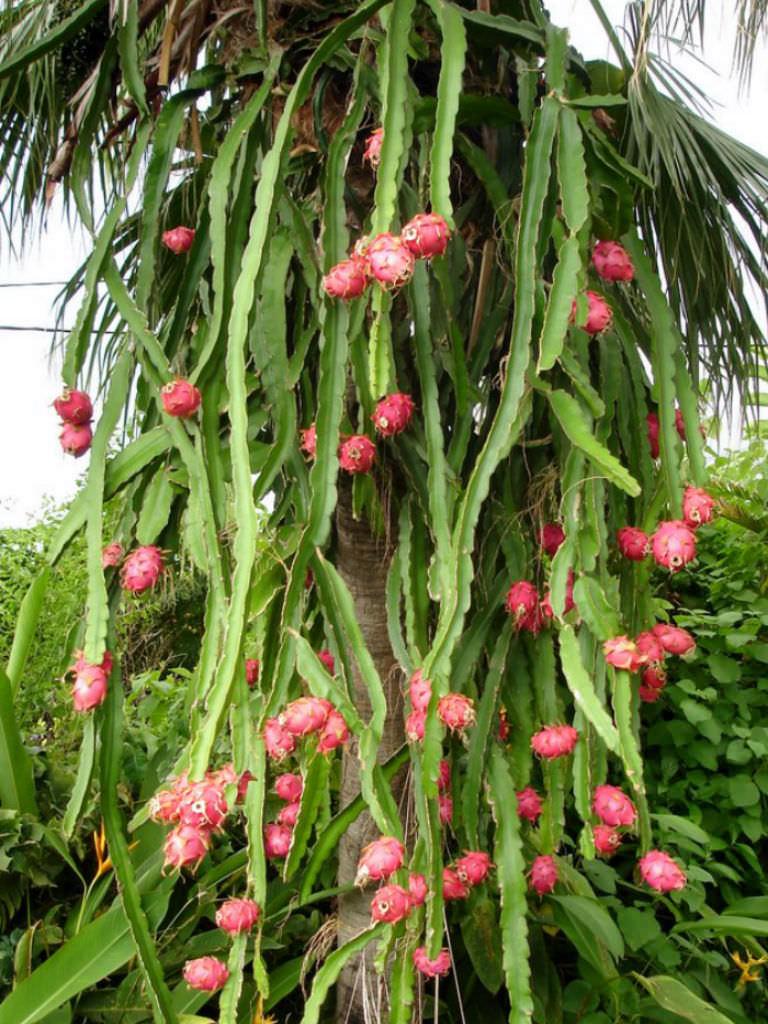
How to Grow and Care
Like most cacti, Cereus are fairly low-maintenance and hardy. Make sure they receive enough water without becoming waterlogged, especially during the summer, and fertilize them for best results. If the roots have become black or overly soft, the cactus could be experiencing root rot – cut away the affected parts and replant. Like all cacti, give them lots of direct sunlight, especially during the summer.
Hylocereus undatus (Haw.) Britton & Rose
Common Names
Night Blooming Cereus, Pitaya, Dragon Fruit, Strawberry Pear, White-Fleshed Pitahaya, Belle of the Night, Moonlight Cactus, Queen of the Night, Red Pitaya, Honolulu Queen, Conderella Plant

Synonyms
Cereus undatus (basionym), Cereus tricostatus, Cereus trigonus var. guatemalensis, Hylocereus tricostatus, Hylocereus guatemalensis
Scientific Classification
Family: Cactaceae
Subfamily: Cactoideae
Tribe: Hylocereeae
Genus: Hylocereus

Description
Hylocereus undatus is a sprawling or vining, terrestrial or epiphytic cactus. The stems are green, 3-winged, up to 16.5 feet (5 m) long and up to 3 inches (7.5 cm) wide. They climb by use of aerial roots and can reach up to 33 feet (10 m) or longer, growing on rocks and trees. Margins are horny and undulate with wings that are up to 2 inches (5 cm) wide. Spines on adult branches are 1 – 3, grayish-brown to black in color and up to 1.2 inches (3 cm) long. The scented, nocturnal flowers are greenish-yellow or whitish, rarely rose-tinged with green outer tepals and bracts, up to 14 inches (35 cm) long and up to 12 inches (30 cm) in diameter. The fruit is oblong to oval, up to 4.7 inches (12 cm) long and up to 3.5 inches (9 cm) thick.

How to Grow and Care
Like most cacti, Cereus are fairly low-maintenance and hardy. Make sure they receive enough water without becoming waterlogged, especially during the summer, and fertilize them for best results. If the roots have become black or overly soft, the cactus could be experiencing root rot – cut away the affected parts and replant. Like all cacti, give them lots of direct sunlight, especially during the summer.
0
0
文章
Dummer. ゛☀
2017年10月01日

Scientific Name
Escobaria vivipara (Nutt.) Buxb.
Common Names
Beehive Cactus, Spinystar, Pincushion Cactus, Viviparous Foxtail Cactus
Synonyms
Cactus viviparus (basionym), Coryphantha vivipara
Scientific Classification
Family: Cactaceae
Subfamily: Cactoideae
Tribe: Cacteae
Genus: Escobaria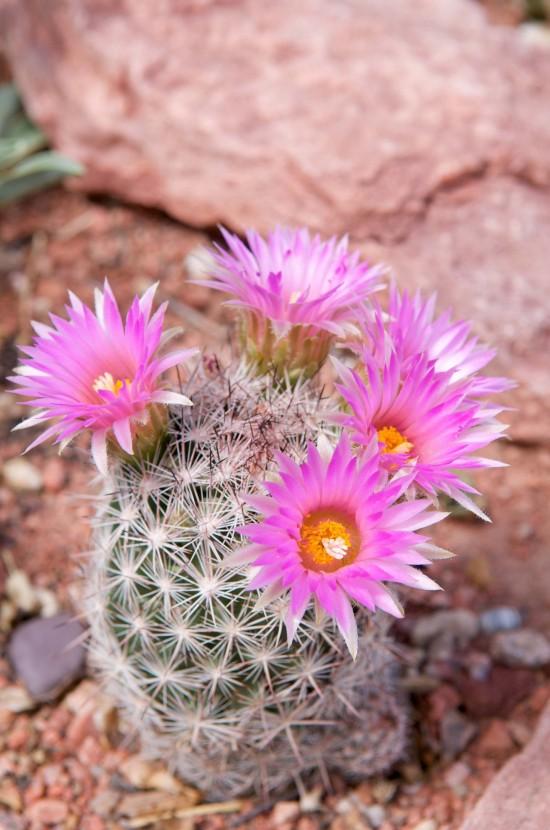
Description
Escobaria vivipara is a small cactus, up to 6 inches (15 cm) tall, often remaining smaller and oblong or spherical. It is densely covered in a mat of star-shaped arrays of straight white spines one to two and a 0.2 inch (5 mm) long. It flowers in yellow, pink, or purple blooms, up to 2 inches (5 cm) across.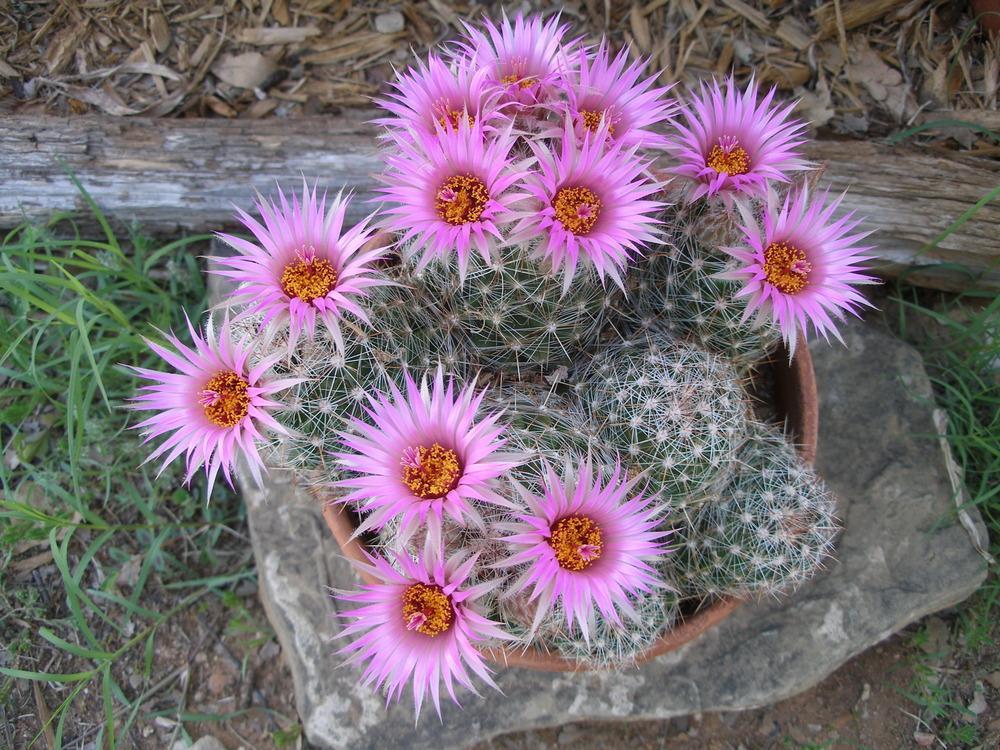
How to Grow and Care
The Escobaria are very susceptible to rot and therefore require a well-drained soil, without any water excess or stagnation; it has been observed that the plants also suffer the environmental humidity, which should preferably remain very low (30-50%). Avoid watering during the winter, when the plant is dormant: watering Escobaria in cold environmental conditions will almost certainly lead to death of the plant. In the growing season the plants, whose growth is typically quite slow, like to perceive a significant temperature difference between night and day. The average winter minimum temperature, in general, should not fall below 42 to 46 °F (6 to 8 °C), unless individual exceptions; adult plants can withstand frosts also very intense, but only if the temperature rises again quickly.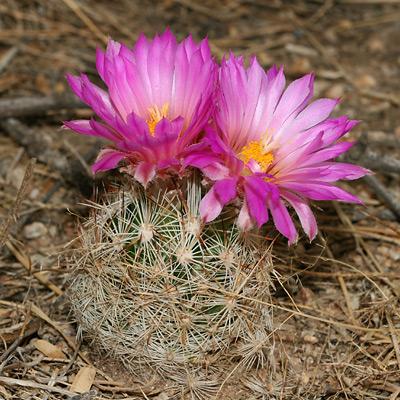
The experienced grower knows well the difficulties of survival of this genus, certainly not one of the easiest to grow.
Escobaria vivipara (Nutt.) Buxb.
Common Names
Beehive Cactus, Spinystar, Pincushion Cactus, Viviparous Foxtail Cactus

Synonyms
Cactus viviparus (basionym), Coryphantha vivipara
Scientific Classification
Family: Cactaceae
Subfamily: Cactoideae
Tribe: Cacteae
Genus: Escobaria

Description
Escobaria vivipara is a small cactus, up to 6 inches (15 cm) tall, often remaining smaller and oblong or spherical. It is densely covered in a mat of star-shaped arrays of straight white spines one to two and a 0.2 inch (5 mm) long. It flowers in yellow, pink, or purple blooms, up to 2 inches (5 cm) across.

How to Grow and Care
The Escobaria are very susceptible to rot and therefore require a well-drained soil, without any water excess or stagnation; it has been observed that the plants also suffer the environmental humidity, which should preferably remain very low (30-50%). Avoid watering during the winter, when the plant is dormant: watering Escobaria in cold environmental conditions will almost certainly lead to death of the plant. In the growing season the plants, whose growth is typically quite slow, like to perceive a significant temperature difference between night and day. The average winter minimum temperature, in general, should not fall below 42 to 46 °F (6 to 8 °C), unless individual exceptions; adult plants can withstand frosts also very intense, but only if the temperature rises again quickly.

The experienced grower knows well the difficulties of survival of this genus, certainly not one of the easiest to grow.
2
1
文章
Dummer. ゛☀
2017年10月01日

Scientific Name
Acanthocereus tetragonus (L.) Hummelinck
Common Names
Barbed Wire Cactus, Sword Pear, Triangle Cactus, Dildo Cactus, Night-Blooming Cereus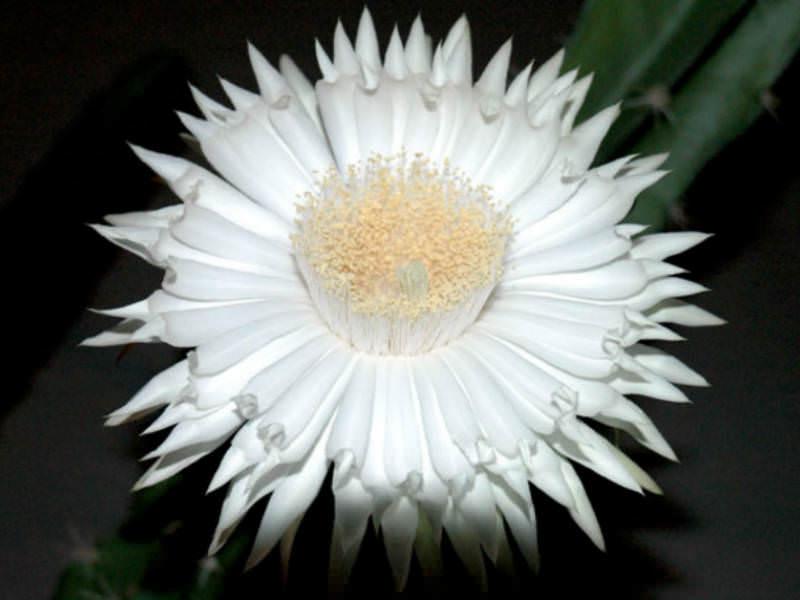
Synonyms
Cactus tetragonus (basionym), Cereus tetragonus, Acanthocereus pentagonus, Acanthocereus pitajaya, Cactus pitajaya, Cereus pitajaya, Cactus pentagonus, Cereus pentagonus, Cereus pentagonus, Cactus pentagonus, Cereus acutangulus, Acanthocereus acutangulus, Cereus princeps, Acanthocereus princeps, Cereus princeps, Cereus variabilis, Acanthocereus floridanus, Acanthocereus colombianus, Cactus prismaticus, Cereus prismaticus, Cactus reptans, Cereus reptans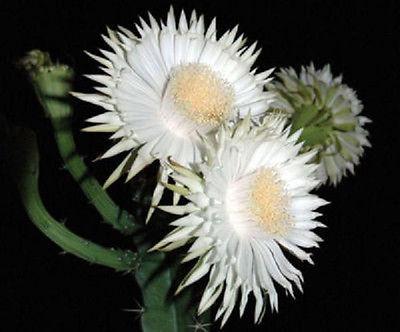
Scientific Classification
Family: Cactaceae
Subfamily: Cactoideae
Tribe: Echinocereeae
Genus: Acanthocereus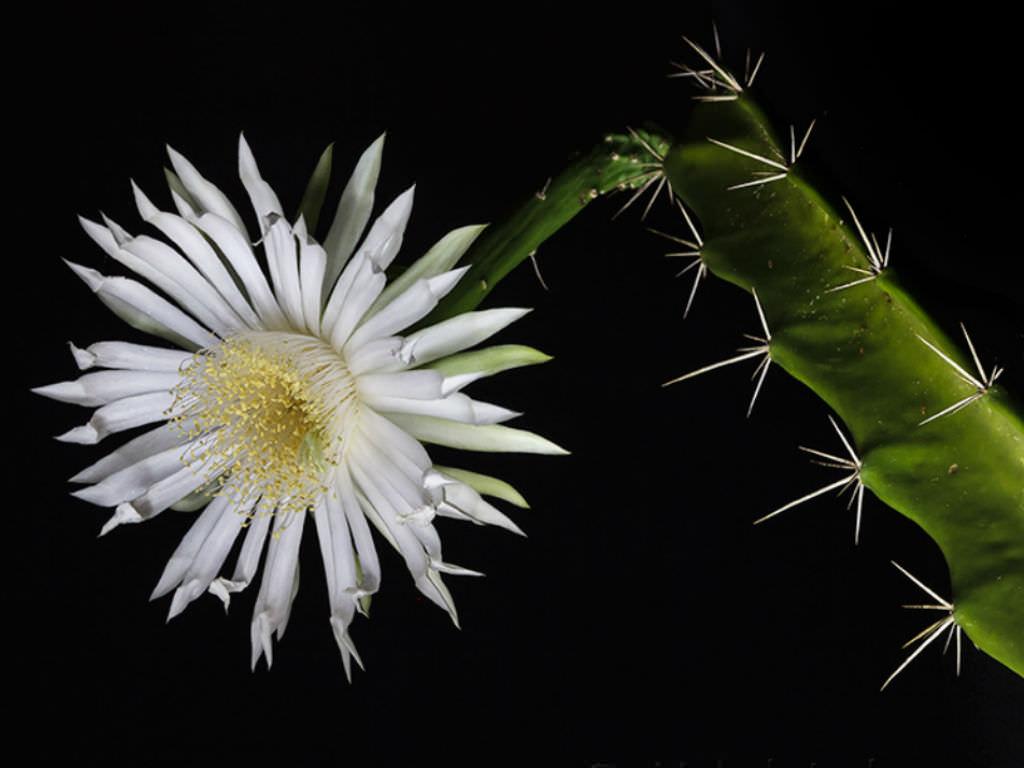
Description
Acanthocereus tetragonus is a tall, columnar cactus, up to 23 feet (7 m) tall. The stems are dark green with 3 – 4 (5) angles and up to 3 inches (8 cm) in diameter. Areoles are grey, up to 1.2 inches (3 cm) from each other. Central areoles have 1 – 2 (3) spines up to 1.6 inches (4 cm) long. Radial areoles have 6 – 8 (10) spines up to 1 inch (2.5 cm) long. The flowers are up to 8 inches (20 cm) in diameter with a tube, up to 6 inches (15 cm) in length. Outer tepals are greenish-white, inner tepals are pure white, and pistils are creamy white. The shiny, red fruits are up to 2 inches (5 cm) long.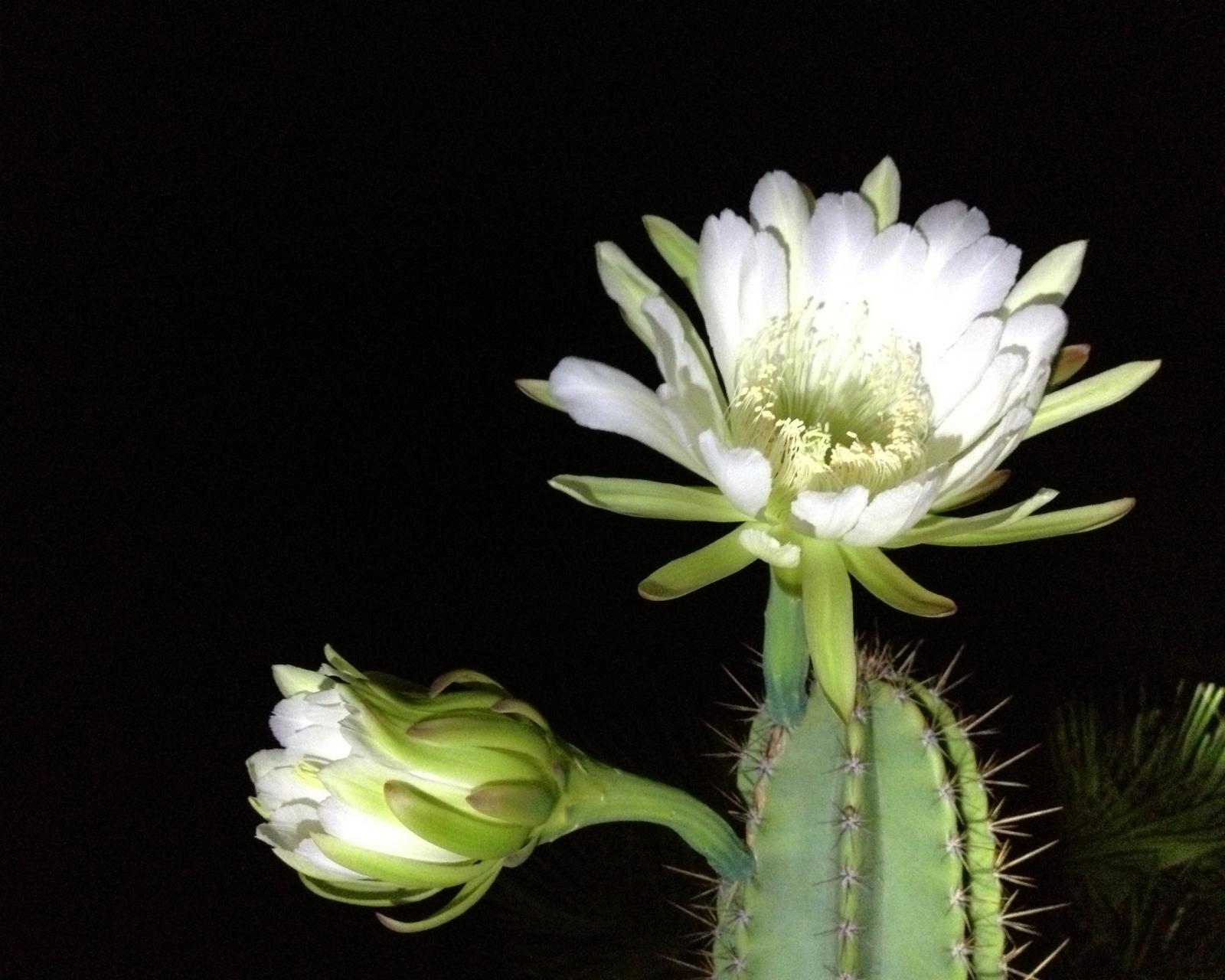
Hardiness
USDA hardiness zone 9a to 11b: from 20 °F (−6.7 °C) to 50 °F (+10 °C).
How to Grow and Care
Like most cacti, Cereus are fairly low-maintenance and hardy. Make sure they receive enough water without becoming waterlogged, especially during the summer, and fertilize them for best results. If the roots have become black or overly soft, the cactus could be experiencing root rot – cut away the affected parts and replant. Like all cacti, give them lots of direct sunlight, especially during the summer.
Acanthocereus tetragonus (L.) Hummelinck
Common Names
Barbed Wire Cactus, Sword Pear, Triangle Cactus, Dildo Cactus, Night-Blooming Cereus

Synonyms
Cactus tetragonus (basionym), Cereus tetragonus, Acanthocereus pentagonus, Acanthocereus pitajaya, Cactus pitajaya, Cereus pitajaya, Cactus pentagonus, Cereus pentagonus, Cereus pentagonus, Cactus pentagonus, Cereus acutangulus, Acanthocereus acutangulus, Cereus princeps, Acanthocereus princeps, Cereus princeps, Cereus variabilis, Acanthocereus floridanus, Acanthocereus colombianus, Cactus prismaticus, Cereus prismaticus, Cactus reptans, Cereus reptans

Scientific Classification
Family: Cactaceae
Subfamily: Cactoideae
Tribe: Echinocereeae
Genus: Acanthocereus

Description
Acanthocereus tetragonus is a tall, columnar cactus, up to 23 feet (7 m) tall. The stems are dark green with 3 – 4 (5) angles and up to 3 inches (8 cm) in diameter. Areoles are grey, up to 1.2 inches (3 cm) from each other. Central areoles have 1 – 2 (3) spines up to 1.6 inches (4 cm) long. Radial areoles have 6 – 8 (10) spines up to 1 inch (2.5 cm) long. The flowers are up to 8 inches (20 cm) in diameter with a tube, up to 6 inches (15 cm) in length. Outer tepals are greenish-white, inner tepals are pure white, and pistils are creamy white. The shiny, red fruits are up to 2 inches (5 cm) long.

Hardiness
USDA hardiness zone 9a to 11b: from 20 °F (−6.7 °C) to 50 °F (+10 °C).
How to Grow and Care
Like most cacti, Cereus are fairly low-maintenance and hardy. Make sure they receive enough water without becoming waterlogged, especially during the summer, and fertilize them for best results. If the roots have become black or overly soft, the cactus could be experiencing root rot – cut away the affected parts and replant. Like all cacti, give them lots of direct sunlight, especially during the summer.
0
0
文章
Dummer. ゛☀
2017年10月01日

Scientific Name
Opuntia ficus-indica (L.) Mill.
Common Names
Indian Fig Opuntia, Indian Fig, Barbary Fig, Cactus Pear, Spineless Cactus, Prickly Pear, Mission Cactus, Mission Prickly Pear, Smooth Mountain Prickly Pear, Smooth Prickly Pear, Sweet Prickly Pear, Tuberous Prickly Pear, Tuna Cactus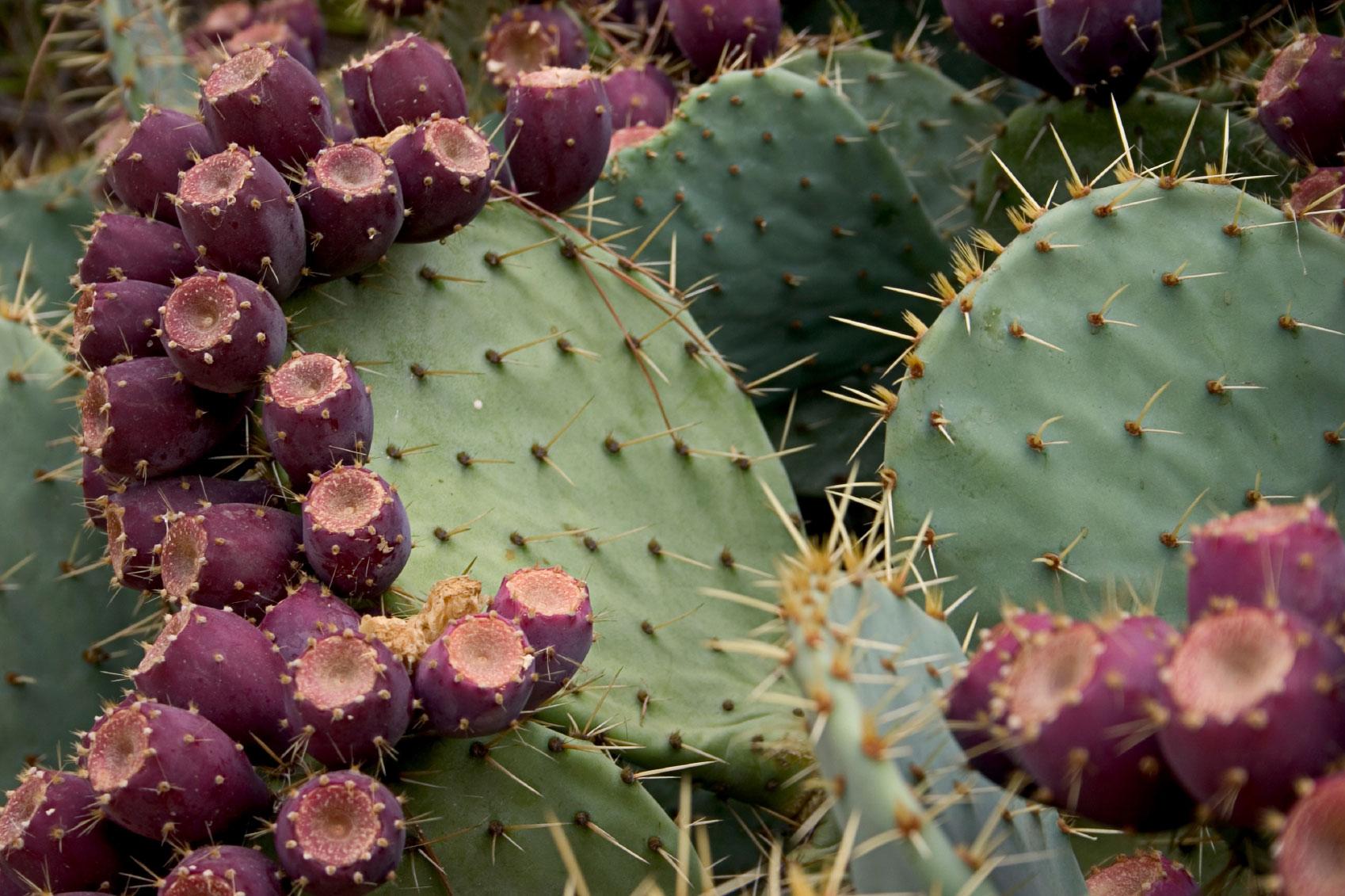
Synonyms
Cactus ficus-indica (basionym), Cactus decumanus, Opuntia amyclaea, Opuntia cordobensis, Opuntia decumana, Opuntia ficus-barbarica, Opuntia gymnocarpa, Opuntia hispanica, Opuntia joconostle, Opuntia maxima, Opuntia megacantha, Opuntia paraguayensis
Scientific Classification
Family: Cactaceae
Subfamily: Opuntioideae
Tribe: Opuntieae
Genus: Opuntia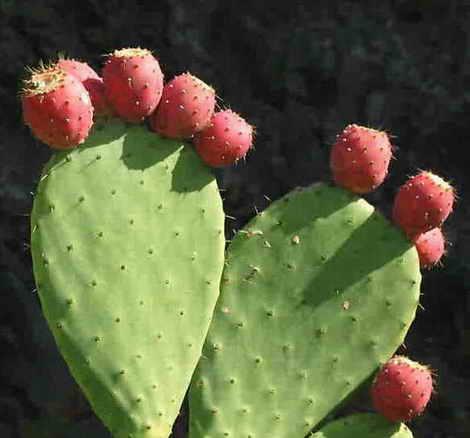
Description
Opuntia ficus-indica is a slow growing perennial shrub up to 16.5 feet (5 m) high. The root-system spreads horizontally. Stems (cladodes) are very thick, succulent, oblong to spatulate, up to 2 feet (60 cm) long and up to 10 inches (25 cm) wide. The epidermis is very thick and waxy, thus very water repellent and sun reflecting. Flowering occurs on 1-2 year-old cladodes. Flowers open in the late morning. The fruit is succulent, reddish, ellipsoid, up to 3 inches (7.5 cm) long and edible.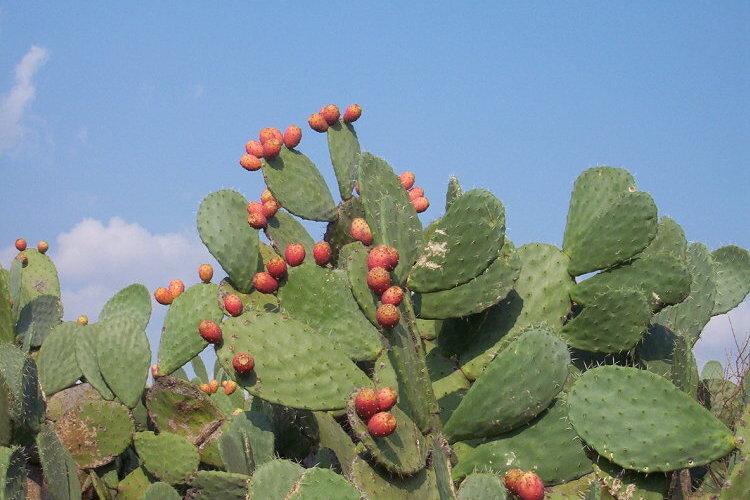
How to Grow and Care
Though the large variety of species within the Opuntia genus means different types of prickly pears may need slightly different care, all are desert cacti that need lots of sun, lots of light, and very little water. If you live in a hot, arid area – particularly the American Southwest – these plants can generally be planted outside, left alone, and enjoyed. Though Opuntia will grow just fine in a garden, they can be grown in pots as well.
To repot, ensure the soil is dry, then remove the pot and knock away the old soil. After treating any cuts with fungicide, place the prickly pear in a new pot and backfill it with potting soil.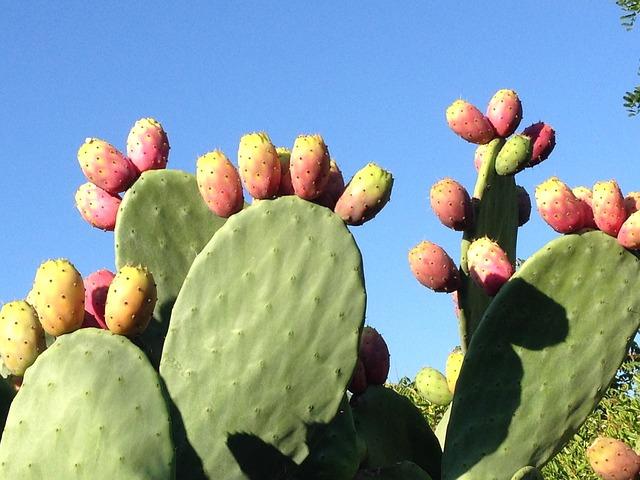
Uses
Opuntia ficus-indica is a species of cactus that has long been a domesticated crop plant important in agricultural economies throughout arid and semiarid parts of the world. It is grown primarily as a fruit crop, but also for the vegetable nopales and other uses. Most culinary references to the “Prickly Pear” are referring to this species.
Opuntia ficus-indica (L.) Mill.

Common Names
Indian Fig Opuntia, Indian Fig, Barbary Fig, Cactus Pear, Spineless Cactus, Prickly Pear, Mission Cactus, Mission Prickly Pear, Smooth Mountain Prickly Pear, Smooth Prickly Pear, Sweet Prickly Pear, Tuberous Prickly Pear, Tuna Cactus

Synonyms
Cactus ficus-indica (basionym), Cactus decumanus, Opuntia amyclaea, Opuntia cordobensis, Opuntia decumana, Opuntia ficus-barbarica, Opuntia gymnocarpa, Opuntia hispanica, Opuntia joconostle, Opuntia maxima, Opuntia megacantha, Opuntia paraguayensis
Scientific Classification
Family: Cactaceae
Subfamily: Opuntioideae
Tribe: Opuntieae
Genus: Opuntia

Description
Opuntia ficus-indica is a slow growing perennial shrub up to 16.5 feet (5 m) high. The root-system spreads horizontally. Stems (cladodes) are very thick, succulent, oblong to spatulate, up to 2 feet (60 cm) long and up to 10 inches (25 cm) wide. The epidermis is very thick and waxy, thus very water repellent and sun reflecting. Flowering occurs on 1-2 year-old cladodes. Flowers open in the late morning. The fruit is succulent, reddish, ellipsoid, up to 3 inches (7.5 cm) long and edible.

How to Grow and Care
Though the large variety of species within the Opuntia genus means different types of prickly pears may need slightly different care, all are desert cacti that need lots of sun, lots of light, and very little water. If you live in a hot, arid area – particularly the American Southwest – these plants can generally be planted outside, left alone, and enjoyed. Though Opuntia will grow just fine in a garden, they can be grown in pots as well.
To repot, ensure the soil is dry, then remove the pot and knock away the old soil. After treating any cuts with fungicide, place the prickly pear in a new pot and backfill it with potting soil.

Uses
Opuntia ficus-indica is a species of cactus that has long been a domesticated crop plant important in agricultural economies throughout arid and semiarid parts of the world. It is grown primarily as a fruit crop, but also for the vegetable nopales and other uses. Most culinary references to the “Prickly Pear” are referring to this species.
0
0
文章
Dummer. ゛☀
2017年10月01日

Scientific Name
Pereskia aculeata Mill.
Common Names
Barbados Gooseberry, Barbados Shrub, Leaf Cactus, Ora-Pro-Nobis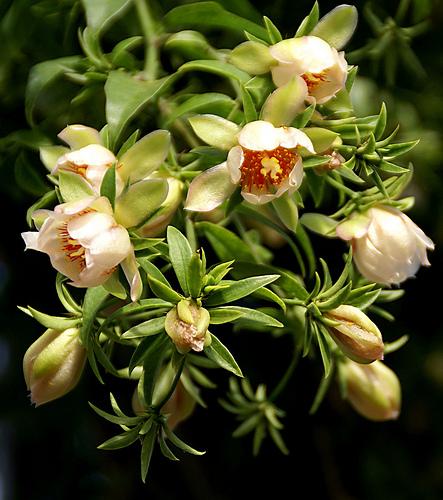
Synonyms
Cactus lucidus, Cactus pereskia, Pereskia foetens, Pereskia fragrans, Pereskia godseffiana, Pereskia longispina, Pereskia pereskia, Pereskia rubescens, Pereskia undulata
Scientific Classification
Family: Cactaceae
Subfamily: Pereskioideae
Genus: Pereskia
Description
Pereskia aculeata is a scrambling vine growing up to 33 feet (10 m) tall in trees, with stems up to 1.2 inches (3 cm) thick. Younger stems have hooked thorns and older stems have clusters of woody spines. The leaves are up to 4 inches (10 cm) long and up to 1.6 inches (4 cm) wide, simple, entire, and deciduous in the dry season. The strongly scented flowers are white, cream or pinkish, up to 2 inches (5 cm) in diameter, and numerous, produced in panicles. The fruit is a rounded berry, translucent white to pink, yellow, orange or red, and up to 0.8 inch (2 cm) in diameter.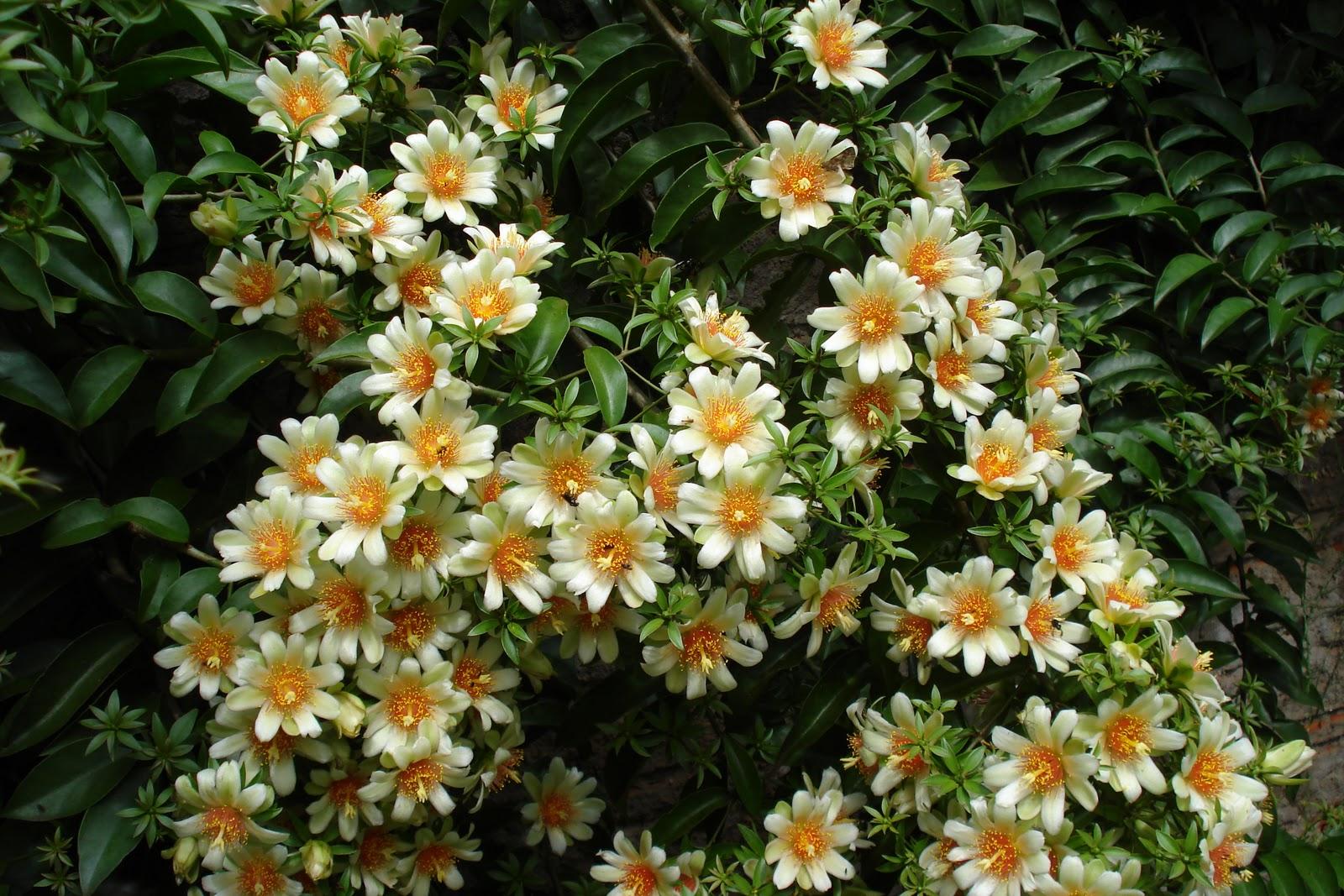
How to Grow and Care
As with many cacti, Pereskias can be almost ignored and still flourish. One of the major advantages that succulents pose as houseplants is their ease, and overwatering or overfeeding them is a bigger danger than neglecting them because it can damage their roots. If you repot them, remember to leave them alone for a brief period so as to avoid overstressing them, and make sure to keep an eye out for common houseplant pests.
Pereskia aculeata Mill.
Common Names
Barbados Gooseberry, Barbados Shrub, Leaf Cactus, Ora-Pro-Nobis

Synonyms
Cactus lucidus, Cactus pereskia, Pereskia foetens, Pereskia fragrans, Pereskia godseffiana, Pereskia longispina, Pereskia pereskia, Pereskia rubescens, Pereskia undulata
Scientific Classification
Family: Cactaceae
Subfamily: Pereskioideae
Genus: Pereskia

Description
Pereskia aculeata is a scrambling vine growing up to 33 feet (10 m) tall in trees, with stems up to 1.2 inches (3 cm) thick. Younger stems have hooked thorns and older stems have clusters of woody spines. The leaves are up to 4 inches (10 cm) long and up to 1.6 inches (4 cm) wide, simple, entire, and deciduous in the dry season. The strongly scented flowers are white, cream or pinkish, up to 2 inches (5 cm) in diameter, and numerous, produced in panicles. The fruit is a rounded berry, translucent white to pink, yellow, orange or red, and up to 0.8 inch (2 cm) in diameter.

How to Grow and Care
As with many cacti, Pereskias can be almost ignored and still flourish. One of the major advantages that succulents pose as houseplants is their ease, and overwatering or overfeeding them is a bigger danger than neglecting them because it can damage their roots. If you repot them, remember to leave them alone for a brief period so as to avoid overstressing them, and make sure to keep an eye out for common houseplant pests.
0
0






